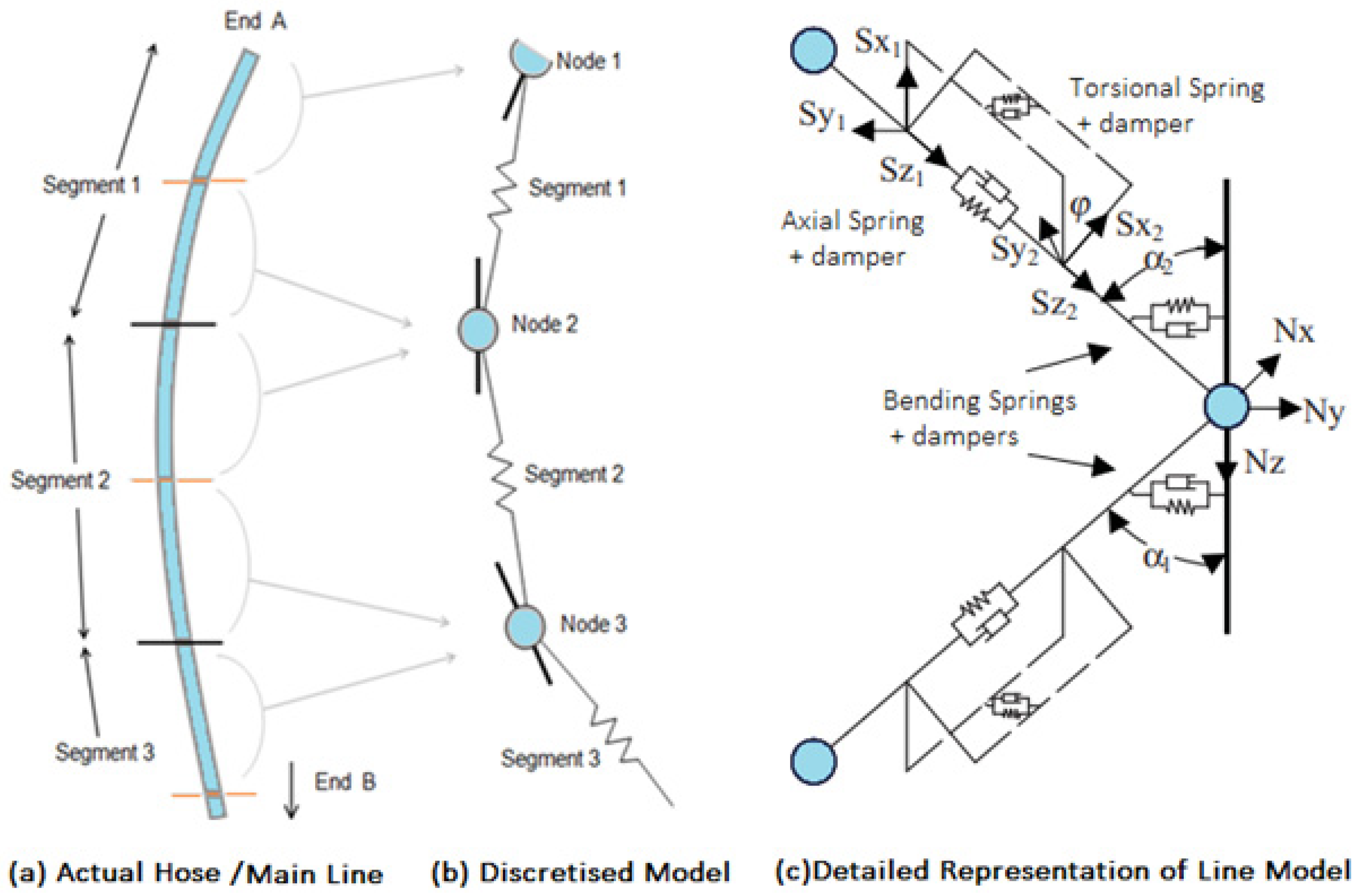Investigation on Hydrodynamic Characteristics, Wave–Current Interaction and Sensitivity Analysis of Submarine Hoses Attached to a CALM Buoy
Abstract
1. Introduction
2. Theory and Governing Equations
2.1. Definition of the Problem
2.2. Assumptions
- The fluid is incompressible, irrotational and is confined within the ocean’s free surface, rigid base and the buoy’s surface.
- The buoy is typically treated as a single system, with a rigid body and 6DoFs.
- The seabed is horizontally oriented and lies upon a rigid plane. The fluid motion considered in the diffraction analysis is in the cylindrical coordinate system with the format (r,ϴ,z).
- The submarine hose is regarded as a beam that can be bent completely within its limit under pure bending.
- The hose will be subjected to longitudinal forces due to internal and external forces. However, in depths with minor effects, the outcomes can be very minimal or negligible.
- The minimum bend radius (MBR) is the inverse of the hose curvature, and the curvature determination can be computed approximately by applying . The bend radius of the hose must always be greater than the MBR.
- Depending on the bending moment, the contribution of both shear pressures and horizontal forces on the curvature is insignificant and can be neglected.
- There will be some nonlinearities inside the hose originating from the fluids motion due to nonlinearities in the hose geometry.
- For all cross-sections perpendicular to the hose axis, the hose is treated as a solid body with constant bending stiffness.
- The hose can also convey (or transport) fluid under high pressure, which can be either oil, gas or water.
- The hose can be made up of various sections, unfloated sections, floated sections, reinforced ends, flanges and various section radii. The rubber, composite as well as steel components of the hose are considered to have a uniform density, by assumption.
- The hose was assumed to contain fluid content and to have fully filled up conditions.
2.3. Boundary Condition Formulation
- (a)
- Dynamic Boundary Conditions:
- (b)
- Kinematic Boundary Conditions:
- (c)
- Free Surface Boundary Conditions:
- (d)
- Body Surface Boundary Conditions:
- (e)
- Seabed (or bottom) Boundary Conditions:
- (f)
- Radiation Boundary Conditions:
2.4. Wave Exciting Forces
2.5. Pressure Distribution
- (a)
- The dynamic pressure distribution is given by Equation (18), where ρ is the density of the fluid, is the velocity of the fluid, which fluctuates as a result of pressure distributions within the fluid, and is the speed of the fluid at a given point, :
- (b)
- The hydrostatic pressure distribution is given by Equation (19), where P0 is the hydrostatic pressure, g is acceleration due to gravity, ρ is the density of the fluid and is the water depth above the level = 0:
- (c)
- The transient pressure distribution is given by Equation (20), where ρ is density of fluid, is the velocity potential while t is the time function:
2.6. Characteristic Value
2.7. Perturbation Method
2.8. Velocity Potential
3. Materials and Methods
3.1. Buoy and Skirt Model
3.2. Submarine Hoses
3.3. Mooring Lines
3.4. Buoyancy Float
3.5. Analysis Method
3.6. Hose Load Cases
3.7. FEM Modeling
3.8. Environmental Conditions
3.9. Buoy Hydrostatics
3.10. Mesh Convergence
3.11. Model Validation
3.12. Dynamic Amplification Factor (DAF)
4. Results and Discussion
4.1. Results of Hydrodynamic Studies
4.1.1. Results of the Coupled and Uncoupled Models
4.1.2. Results of the Hose Curvature Sensitivity
4.1.3. Results of the Hose Effective Tension Sensitivity
4.1.4. Results of Hose Bending Moment Sensitivity
4.1.5. Results of DAF of hose (DAFhose) Sensitivity
4.2. Results of the Wave–Current Interactions
4.2.1. Results of the Current on Buoy Motion RAOs (Response Amplitude Operators)
4.2.2. Results of the Current on First-Order Wave Forces from CALM Buoy Motion
4.2.3. Results of the Seabed Current and Surface Current Sensitivity on Hose
4.2.4. Results of the Current Attack Angle Sensitivity on Marine Hose
4.2.5. Results of the Time Response Sensitivity for the CALM Buoy System
5. Further Discussion
- A number of deformations were observed in the hose occurs where the MBR is high. Similarly, some curvature distributions are observed from the behavior of the submarine hoses via dynamic analysis. The models of the 0° flow angle have the highest curvatures via the arc length of the hose in both configurations. However, the 90° flow angle models reflected minimal curvature via the arc length of the hose. Damping is one method to minimize hose curvatures, in addition to inclusion of the hydrodynamic loads. It was also observed that the hoses subjected to cross-flow directions in the cases for 0° and greater curvatures developed on inclusion of the hydrodynamic loads.
- In comparing the models for Lazy-S and Chinese-lantern configurations, while the curvature plot in the Lazy-S cases sag, the plot in the Chinese-lantern cases is hugging. Additionally, the curvatures in the Lazy-S appear to have higher curvatures; however, this can be due to the profile length of the hose-string and the azimuthal direction of the hose. However, the comparative studies on both configurations in effective tensions show that there are higher distributions recorded in the Lazy-S case than the Chinese-lantern case, but the Chinese-lantern case has more fluctuations than the Lazy-S case. This is attributed to emanate from bending in response to waves and currents. The bending moment behavior resulted from the twisting of the hose. For the bending moment cases, more undulations are observed in the Lazy-S cases than the Chinese-lantern cases, which is due to the longer length of the submarine hoses, and the floats attached on the submarine hose-string in the Lazy-S configuration.
- It was also observed that the cross-flow model cases, particularly the case 0° and case 180° exhibited greater tensions in comparison to the case 90°. Thus, it can be deduced that an increase in the effective tension can be induced by increasing the hydromantic loads of the hose. In addition, the points of attachment of the hoses to the PLEM and to the manifold underneath the CALM buoy both exhibited maximum effective tensions that were of high magnitudes. Thus, the angle of inclination of design for the manifold is recommended to be at about 30°, as this manifold angle enhanced better results, but it is also subject to the manufacturer’s choice, the environmental conditions and the marine hose properties.
- The sensitivity of the soil characteristics shows a high significant influence on the hose-line behavior and seabed resistance on the lower end of the hose, the PLEM and any attached submarine pipeline. An increase in the soil mudline shear strength increases the seabed resistance rises steadily. This means that if submarine hoses are attached to the PLEM, there will be a noticeable dynamic lay effect. As the shear strength gradient increases, the submarine pipeline embedment will have a corresponding dynamic lay effect.
- The sensitivity of seabed resistance on the hose-string shows that the highest soil shear stiffness of 100 kN/m/m2 had the least bending moment, and the least effective tension under nonlinear seabed model, which shows the influence of variation or nonlinearity due to the rate of penetration, seabed soil resistance and uplift on the seabed.
- As the surface current velocity increases, the bend radius (curvature) decreases, the bending moment decreases and the effective tension increases. Considering the seabed currents, the following seabed current velocities were considered: 0.35 m/s, 0.45 m/s, 0.75 m/s and 0.9 m/s. For the same surface current velocity, an increase in the seabed current velocity has a reduced effective tension and reduced bending moment. An increase in the seabed current velocity gives a reduced bend radius (Curvature) and an increased effective tension and bending moment.
- The surface wave is highly significant in the dynamic responses of the hose-line, the buoy stability and the seabed resistance. The most critical wave direction is the following sea (0° flow angle) and followed by the stern-quartering seas (30° and 60° flow angle). Naturally, an increase in wave height increases the submarine hoses’ dynamic responses and seabed resistance. However, we suggest that future studies investigate the approximations analytically for the moving boundary of submarine hoses and the description of the moving boundary of submarine hoses, as such formulation is necessary for further understanding the stability and dynamics behavior.
- This study also shows that there is a variation in the effect of the current velocity from different motion characteristics due to the resonating frequency, the effect of the current velocity is relative to the motion—if translational, such as surge and heave, or rotational, such as pitch and yaw. In the case of the heave, the frequency profile is higher from 0.299 Hz to 1.223 Hz, unlike in the surge motion where the frequency profile is 0.179 Hz to 0.278 Hz. This behavior shows a relationship between first-order wave forces and the three current velocities investigated. Similar findings were observed when current velocity was investigated for the motion RAOs of the CALM buoy.
6. Concluding Remarks
Author Contributions
Funding
Institutional Review Board Statement
Informed Consent Statement
Data Availability Statement
Acknowledgments
Conflicts of Interest
Abbreviations
| ρ | Density of water |
| ω | Angular frequency |
| Peak angular frequency | |
| γ | Peak enhancement factor |
| η | The incident wave amplitude |
| λ | Wavelength |
| θ | Angle to the horizontal axis |
| 3D | Three Dimensional |
| 6DoF | Six Degrees of Freedom |
| ABS | American Bureau of Shipping |
| BEM | Boundary Element Method |
| BM | Bending Moment |
| BVP | Boundary Value Problem |
| CAD | Computer-Aided Design |
| CALM | Catenary Anchor Leg Mooring |
| CB | Cylindrical Buoy |
| CCS | Cartesian Coordinate System |
| CFD | Computational Fluid Dynamics |
| CMS | Conventional Mooring Systems |
| DAF | Dynamic Amplification Factor |
| DAFhose | Dynamic Amplification Factor of hose |
| DNVGL | Det Norkse Veritas & Germanischer Lloyd |
| FEA | Finite Element Analysis |
| FEM | Finite Element Model |
| FOS | Floating Offshore Structure |
| FPSO | Floating Production Storage and Offloading |
| FSO | Floating Storage and Offloading |
| GMPHOM | Guide to Manufacturing and Purchasing Hoses for Offshore Moorings |
| HEV | Hose End Valve |
| HOT | Higher Order Terms |
| Hs | Significant wave height |
| ID | Inner Diameter |
| JONSWAP | Joint North Sea Wave Project |
| IVC | Initial Boundary Condition |
| MBC | Marine Breakaway Coupling |
| MBR | Minimum Bearing Radius |
| MSL | Mean Sea Level |
| OCIMF | Oil Companies International Marine Forum |
| OD | Outer Diameter |
| PCSemi | Paired Column Semisubmersible |
| PLEM | Pipeline End Manifold |
| QTF | Quadratic Transfer Function |
| RAO | Response Amplitude Operator |
| s | Arc length |
| SB | Mean Wetted Surface |
| SCR | Steel Catenary Riser |
| SLWR | Steel Lazy Wave Catenary Risers |
| SPM | Single Point Mooring |
| TDP | Touch Down Point |
| TDZ | Touch Down Zone |
| te-m | metric tonne-meter |
| TH | Horizontal tension force |
| Tp | Peak period |
| Tv | Vertical tension force |
| TTR | Top Tensioned Riser |
| Tz | Zero crossing period |
| VIV | Vortex Induced Vibration |
| VLFS | Very Large Floating Structures |
| WCI | Waves-Current Interaction |
| WEC | Wave Energy Converters |
| ws | Submerged weight |
| WSI | Wave–Structure Interaction |
| x | Section length of the mooring line |
| z | Height above seabed |
References
- Amaechi, C.V. Novel Design, Hydrodynamics and Mechanics of Marine Hoses in Oil/Gas Applications: Case Study of Marine Hoses. Ph.D. Thesis, Engineering Department, Lancaster University, Lancaster, UK, 2022. [Google Scholar]
- Amaechi, C.V.; Ye, J. A numerical modeling approach to composite risers for deep waters. In Proceedings of the International Conference on Composite Structures (ICCS20) Proceedings, Paris, France, 4–7 September 2017; Società Editrice Esculapio: Bologna, Italy, 2017. [Google Scholar]
- Amaechi, C.V.; Odijie, A.C.; Sotayo, A.; Wang, F.; Hou, X.; Ye, J. Recycling of Renewable Composite Materials in the Offshore Industry. Encycl. Renew. Sustain. Mater. 2020, 2, 583–613. [Google Scholar] [CrossRef]
- Amaechi, C.V.; Odijie, A.C.; Orok, E.O.; Ye, J. Economic Aspects of Fiber Reinforced Polymer Composite Recycling. Encycl. Renew. Sustain. Mater. 2020, 2, 377–397. [Google Scholar] [CrossRef]
- Amaechi, C.V.; Ye, J. Local tailored design of deep water composite risers subjected to burst, collapse and tension loads. Ocean Eng. 2022, in press. [CrossRef]
- Amaechi, C.V.; Ye, J. A review of state-of-the-art and meta-science analysis on composite risers for deep seas. Ocean Eng. 2021; under review. [Google Scholar]
- Amaechi, C.V.; Ye, J. Development of composite risers for offshore applications with review on design and mechanics. Ships Offshore Struct. 2021; under review. [Google Scholar]
- Amaechi, C.V.; Chesterton, C.; Butler, H.O.; Wang, F.; Ye, J. An Overview on Bonded Marine Hoses for sustainable fluid transfer and (un)loading operations via Floating Offshore Structures (FOS). J. Mar. Sci. Eng. 2021, 9, 1236. [Google Scholar] [CrossRef]
- Amaechi, C.V.; Chesterton, C.; Butler, H.O.; Wang, F.; Ye, J. Review on the design and mechanics of bonded marine hoses for Ca-tenary Anchor Leg Mooring (CALM) buoys. Ocean Eng. 2021, 242, 110062. [Google Scholar] [CrossRef]
- Ye, J.; Cai, H.; Liu, L.; Zhai, Z.; Amaechi, C.V.; Wang, Y.; Wan, L.; Yang, D.; Chen, X.; Ye, J. Microscale intrinsic properties of hybrid unidirectional/woven composite laminates: Part I experimental tests. Compos. Struct. 2021, 262, 113369. [Google Scholar] [CrossRef]
- Amaechi, C.V.; Gillett, N.; Odijie, A.C.; Hou, X.; Ye, J. Composite risers for deep waters using a numerical modelling approach. Compos. Struct. 2019, 210, 486–499. [Google Scholar] [CrossRef]
- Amaechi, C.V.; Gillett, N.; Odijie, A.C.; Wang, F.; Hou, X.; Ye, J. Local and Global Design of Composite Risers on Truss SPAR Platform in Deep waters. In Proceedings of the 5th International Conference on Mechanics of Composites, Instituto Superior de Tecnico, Lisbon, Portugal, 1–4 July 2019; No. 20005. pp. 1–3. Available online: https://eprints.lancs.ac.uk/id/eprint/136431/4/Local_and_Global_analysis_of_Composite_Risers_MechComp2019_Conference_Victor.pdf (accessed on 19 May 2021).
- Amaechi, C.V.; Adefuye, E.F.; Oyetunji, A.K.; Ja’e, I.A.; Adelusi, I.; Odijie, A.C.; Wang, F. Numerical Study on Plastic Strain Distributions and Mechanical Behaviour of a Tube under Bending. Inventions 2022, 7, 9. [Google Scholar] [CrossRef]
- Wang, F. Effective design of submarine pipe-in-pipe using Finite Element Analysis. Ocean Eng. 2018, 153, 23–32. [Google Scholar] [CrossRef]
- Wang, F.-C.; Han, L.-H. Analytical behavior of carbon steel-concrete-stainless steel double-skin tube (DST) used in submarine pipeline structure. Mar. Struct. 2019, 63, 99–116. [Google Scholar] [CrossRef]
- Wang, F.-C.; Han, L.-H.; Li, W. Analytical behavior of CFDST stub columns with external stainless steel tubes under axial compression. Thin-Walled Struct. 2018, 127, 756–768. [Google Scholar] [CrossRef]
- Wang, J.-T.; Wang, F.-C. Analytical behavior of built-up square concrete-filled steel tubular columns under combined preload and axial compression. Steel Compos. Struct. 2021, 38, 617–635. [Google Scholar] [CrossRef]
- EMSTEC. EMSTEC Loading & Discharge Hoses for Offshore Moorings; EMSTEC: Rosengarten, Germany, 2016; Available online: https://denialink.eu/pdf/emstec.pdf (accessed on 29 September 2021).
- Yokohama. Seaflex Yokohama Offshore Loading & Discharge Hose; The Yokohama Rubber Co. Ltd.: Hiratsuka City, Japan, 2016; Available online: https://www.y-yokohama.com/global/product/mb/pdf/resource/seaflex.pdf (accessed on 17 May 2021).
- Amaechi, C.V.; Wang, F.; Ye, J. Numerical studies on CALM buoy motion responses and the effect of buoy geometry cum skirt dimensions with its hydrodynamic waves-current interactions. Ocean Eng. 2021, 244, 110378. [Google Scholar] [CrossRef]
- Amaechi, C.V.; Chesterton, C.; Odijie, A.C.; Ye, J. Numerical assessment of offshore hose load response during reeling and free-hanging operations under ocean waves. Ocean Eng. 2021; under review. [Google Scholar]
- Amaechi, C.V.; Chesterton, C.; Butler, H.O.; Gu, Z.; Odijie, A.C.; Wang, F. Finite element modelling on the mechanical behaviour of Marine Bonded Composite Hose (MBCH) under burst and collapse. J. Mar. Sci. Eng. 2022, 10. under review. [Google Scholar]
- Amaechi, C.V.; Wang, F.; Ye, J. Understanding the fluid-structure interaction from wave diffraction forces on CALM buoys: Numerical and analytical solutions. Ships Offshore Struct. 2021. [Google Scholar] [CrossRef]
- Amaechi, C.V.; Wang, F.; Ye, J. Numerical Assessment on the Dynamic Behaviour of Submarine Hoses Attached to CALM Buoy Configured as Lazy-S under Water Waves. J. Mar. Sci. Eng. 2021, 9, 1130. [Google Scholar] [CrossRef]
- Amaechi, C.V.; Wang, F.; Ye, J. Experimental study on motion characterization of CALM buoy hose system under water waves. J. Mar. Sci. Eng. 2022; under review. [Google Scholar]
- Amaechi, C.V.; Wang, F.; Ye, J. An investigation on the vortex effect of a CALM buoy under water waves using Computational Fluid Dynamics (CFD). Inventions, 2022; under review. [Google Scholar]
- Odijie, A.C.; Ye, J. Effect of Vortex Induced Vibration on a Paired-Column Semisubmersible Platform. Int. J. Struct. Stab. Dyn. 2015, 15, 1540019. [Google Scholar] [CrossRef]
- Odijie, A.C.; Wang, F.; Ye, J. A review of floating semisubmersible hull systems: Column stabilized unit. Ocean Eng. 2017, 144, 191–202. [Google Scholar] [CrossRef]
- Odijie, A.C.; Ye, J. Understanding Fluid-Structure Interaction for high amplitude wave loadings on a deep-draft paired column semi-submersible platform: A finite element approach. In Proceedings of the International Conference on Light Weight Design of Marine Structures, Glasgow, UK, 9–11 November 2015. [Google Scholar]
- Amaechi, C.V.; Odijie, A.C.; Wang, F.; Ye, J. Parametric investigation on tensioner stroke analysis, recoil analysis and disconnect for the marine drilling riser of a Paired Column Semisubmersible under deep water waves. Ocean Eng. 2021; under review. [Google Scholar]
- Amaechi, C.V.; Wang, F.; Ye, J. Dynamic analysis of tensioner model applied on global response of marine riser recoil and disconnect. Ocean Eng. 2022; under review. [Google Scholar]
- Odijie, A.C.; Quayle, S.; Ye, J. Wave induced stress profile on a paired column semisubmersible hull formation for column reinforcement. Eng. Struct. 2017, 143, 77–90. [Google Scholar] [CrossRef]
- Amaechi, C.V.; Odijie, A.C.; Wang, F.; Ye, J. Numerical investigation on mooring line configurations of a Paired Column Semisubmersible for its global performance in deep water condition. Ocean Eng. 2021. [Google Scholar] [CrossRef]
- OCIMF. Guide to Manufacturing and Purchasing Hoses for Offshore Moorings (GMPHOM); Witherby Seamanship International Ltd.: Livingstone, UK, 2009. [Google Scholar]
- OCIMF. Guideline for the Handling, Storage, Inspection and Testing of the Hose, 2nd ed.; Witherby & Co. Ltd.: London, UK, 1995. [Google Scholar]
- OCIMF. Single Point Mooring Maintenace and Operations Guide (SMOG); Witherby & Co. Ltd.: London, UK, 1995. [Google Scholar]
- Amaechi, C.V. Single Point Mooring (SPM) Hoses and Catenary Anchor Leg Mooring (CALM) Buoys. LinkedIn Pulse. Published on 26 July 2021. Available online: https://www.linkedin.com/pulse/single-point-mooring-spm-hoses-catenary-anchor-leg-calm-amaechi (accessed on 1 September 2021).
- Trelleborg. Trelleborg Fluid Handling Solutions. Oil & Marine Hoses: Innovation and Safety for Oil & Gas Transfer Systems. In Trelleborg Oil & Gas Solutions: Oil & Gas Hoses for Enhanced Fluid Transfer Solutions; Trelleborg: Clemont-Ferrand, France, 2018; Volume 1, pp. 1–30. [Google Scholar]
- Bluewater Energy Services. Buoyed Up: The Future of Tanker Loading/Offloading Operations; Bluewater Energy Services: Amsterdam, The Netherlands, 2009; Available online: https://www.bluewater.com/wp-content/uploads/2013/04/CALM-Buoy-brochure-English.pdf (accessed on 18 July 2021).
- Continental. Marine Hose Brochure. 2020. Available online: https://aosoffshore.com/wp-content/uploads/2020/02/ContiTech_Marine-Brochure.pdf (accessed on 17 February 2021).
- Trelleborg. Surface Buoyancy. Trelleborg Marine and Infrastructure: Product Brochure. Ref.: BC-SUR-v1.3. Trelleborg Sweden. 2017. Available online: https://www.trelleborg.com/en/marine-and-infrastructure/products-solutions-and-services/marine/surface-buoyancy (accessed on 30 September 2021).
- Bluewater Energy Services. Oceans of Knowledge; Bluewater Energy Services: Amsterdam, The Netherlands, 2019; pp. 1–20. [Google Scholar]
- OIL. Offloading Hoses: Floating & Submarine Hoses-OIL Hoses Brochure; Offspring International Limited: Dudley, UK, 2014; Available online: https://www.offspringinternational.com/wp-content/uploads/2020/06/OIL-Offloading-Hoses-Brochure-2020-W.pdf (accessed on 12 July 2021).
- OIL. Mooring and Offloading Systems; Offspring International Limited: Dudley, UK, 2015; Available online: https://www.offspringinternational.com/wp-content/uploads/2015/04/OIL-SPM-Brochure-2015.pdf (accessed on 12 July 2021).
- Bluewater. Conventional Buoy Mooring Systems; Bluewater Energy Services: Amsterdam, The Netherlands, 2009. [Google Scholar]
- Bluewater. Turret Buoy; Bluewater Energy Services: Amsterdam, The Netherlands, 2016. [Google Scholar]
- ContiTech. Marine Hoses-Offshore Fluid Transfer. Contitech Oil & Gas, UK. 2017. Available online: http://www.contitech-oil-gas.com/pages/marine-hoses/marine-hoses_en.html (accessed on 30 September 2021).
- ContiTech. High Performance Flexible Hoses Brochure; Contitech Oil & Gas: Grimsby, UK, 2014. [Google Scholar]
- Bluewater. Bluewater Turret Buoy-Technical Description; Bluewater Energy Services: Amsterdam, The Netherlands, 2011. [Google Scholar]
- Constantin, A.; Ivanov, R.; Martin, C.I. Hamiltonian Formulation for Wave-Current Interactions in Stratified Rotational Flows. Arch. Ration. Mech. Anal. 2016, 221, 1417–1447. [Google Scholar] [CrossRef]
- Chen, Y.; Chen, L.; Zhang, H.; Gong, W. Effects of wave-current interaction on the Pearl River Estuary during Typhoon Hato. Estuar. Coast. Shelf Sci. 2019, 228, 106364. [Google Scholar] [CrossRef]
- Hegermiller, C.A.; Warner, J.C.; Olabarrieta, M.; Sherwood, C.R. Wave–Current Interaction between Hurricane Matthew Wave Fields and the Gulf Stream. J. Phys. Oceanogr. 2019, 49, 2883–2900. [Google Scholar] [CrossRef]
- Jia, L.; Ren, J.; Nie, D.; Chen, B.; Lv, X. Wave-current bottom shear stresses and sediment re-suspension in the mouth bar of the Modaomen Estuary during the dry season. Acta Oceanol. Sin. 2014, 33, 107–115. [Google Scholar] [CrossRef]
- Beya, I.; Buckham, B.; Robertson, B. Impact of tidal currents and model fidelity on wave energy resource assessments. Renew. Energy 2021, 176, 50–66. [Google Scholar] [CrossRef]
- Odijie, A.C. Design of Paired Column Semisubmersible Hull. Ph.D. Thesis, Engineering Department, Lancaster University, Lancaster, UK, 2016. Available online: https://eprints.lancs.ac.uk/id/eprint/86961/1/2016AgbomeriePhD.pdf (accessed on 12 February 2020).
- Mohamed, H.A.M.A. Hydrodynamic Loading and Responses of Semisubmersibles. Ph.D. Thesis, School of Marine Science and Technology, Newcastle University, Newcastle upon Tyne, UK, 2011. Available online: https://theses.ncl.ac.uk/jspui/bitstream/10443/1285/1/Hassan%20Mohamed%2011.pdf (accessed on 6 October 2021).
- Chen, L.; Basu, B. Fatigue load estimation of a spar-type floating offshore wind turbine considering wave-current interactions. Int. J. Fatigue 2018, 116, 421–428. [Google Scholar] [CrossRef]
- Henriques, T.D.J.; Tedds, S.; Botsari, A.; Najafian, G.; Hedges, T.; Sutcliffe, C.; Owen, I.; Poole, R. The effects of wave–current interaction on the performance of a model horizontal axis tidal turbine. Int. J. Mar. Energy 2014, 8, 17–35. [Google Scholar] [CrossRef]
- Hirdaris, S.; Bai, W.; Dessi, D.; Ergin, A.; Gu, X.; Hermundstad, O.; Huijsmans, R.; Iijima, K.; Nielsen, U.; Parunov, J.; et al. Loads for use in the design of ships and offshore structures. Ocean Eng. 2013, 78, 131–174. [Google Scholar] [CrossRef]
- Bai, Y.; Bai, Q. Subsea Pipelines and Risers, 1st ed.; Elsevier: Oxford, UK, 2005. [Google Scholar]
- Bai, Y.; Bai, Q. Subsea Engineering Handbook; Elsevier: Oxford, UK, 2010. [Google Scholar]
- Wichers, I.J. Guide to Single Point Moorings; WMooring Inc.: Houston, TX, USA, 2013; Available online: http://www.wmooring.com/files/Guide_to_Single_Point_Moorings.pdf (accessed on 18 December 2021).
- Berteaux, H.O. Buoy Engineering; John Wiley and Sons: New York, NY, USA, 1976. [Google Scholar]
- Berteaux, H.O.; Goldsmith, R.A.; Schott, W.E., III. Heave and Roll Response of Free Floating Bodies of Cylindrical Shape; Report WHOI-77-12; Woods Hole Oceanographic Institution: Massachusetts, MA, USA, 1977; Available online: https://apps.dtic.mil/sti/pdfs/ADA038215.pdf (accessed on 15 August 2021).
- Wilson, J.F. Dynamics of Offshore Structures, 2nd ed.; John Wiley and Sons: Hoboken, NJ, USA, 2003. [Google Scholar]
- Sorensen, R.M. Basic Coastal Engineering, 3rd ed.; Springer: New York, NY, USA, 2006. [Google Scholar]
- Sorensen, R.M. Basic Wave Mechanics: For Coastal and Ocean Engineers; John Wiley and Sons: London, UK, 1993. [Google Scholar]
- Havelock, T.H. The pressure of water waves upon a fixed obstacle. Proc. R. Soc. Lond. Ser. A Math. Phys. Sci. 1940, 175, 409–421. [Google Scholar] [CrossRef]
- MacCamy, R.C.; Fuchs, R.A. Wave Forces on Piles: A Diffraction Theory; Report BEB-TM-69; Beach Erosion Board, Department of Army: Washington, DC, USA, 1954; pp. 1–17. Available online: https://erdc-library.erdc.dren.mil/jspui/bitstream/11681/3444/1/BEB-TM-69.pdf (accessed on 8 September 2021).
- Chakrabarti, S.K. Nonlinear wave forces on vertical cylinder. J. Hydraul. Div. 1972, 98, 1895–1909. [Google Scholar] [CrossRef]
- Chakrabarti, S.K. Second-Order Wave Force on Large Vertical Cylinder. J. Waterw. Harb. Coast. Eng. Div. 1975, 101, 311–317. [Google Scholar] [CrossRef]
- Rahman, M. Non-linear wave loads on large circular cylinders: A perturbation technique. Adv. Water Resour. 1981, 4, 9–19. [Google Scholar] [CrossRef]
- Rahman, M. Second order wave interaction with large structures. In Wave Phenomena: Modern Theory and Applications; Rogers, T.B.M.C., Ed.; North-Holland Mathematics Studies; Elsevier B.V: North Holland, The Netherlands, 1984; Volume 97, pp. 49–69. [Google Scholar] [CrossRef]
- Newman, J.N. The second-order wave force on a vertical cylinder. J. Fluid Mech. 1996, 320, 417–443. [Google Scholar] [CrossRef]
- Ghalayini, S.; Williams, A. Nonlinear wave forces on vertical cylinder arrays. J. Fluids Struct. 1991, 5, 1–32. [Google Scholar] [CrossRef]
- Zhang, S.-F.; Chen, C.; Zhang, Q.-X.; Zhang, N.-M.; Zhang, F. Wave Loads Computation for Offshore Floating Hose Based on Partially Immersed Cylinder Model of Improved Morison Formula. Open Pet. Eng. J. 2015, 8, 130–137. [Google Scholar] [CrossRef][Green Version]
- Liu, B.; Fu, D.; Zhang, Y.; Chen, X. Experimental and numerical study on the wave force calculation of a partially immersed horizontal cylindrical float. Int. J. Nav. Arch. Ocean Eng. 2020, 12, 733–742. [Google Scholar] [CrossRef]
- Morison, J.; Johnson, J.; Schaaf, S. The Force Exerted by Surface Waves on Piles. J. Pet. Technol. 1950, 2, 149–154. [Google Scholar] [CrossRef]
- Brebbia, C.A.; Walker, S. Dynamic Analysis of Offshore Structures, 2013 Reprint of 1979 ed.; Newnes-Butterworth & Co. Publishers Ltd.: London, UK, 2013. [Google Scholar]
- Sarpkaya, T. Wave Forces on Offshore Structures, 1st ed.; Cambridge University Press: New York, NY, USA, 2014. [Google Scholar]
- Chandrasekaran, S. Dynamic Analysis and Design of Offshore Structures, 1st ed.; Springer: New Delhi, India, 2015. [Google Scholar]
- Chandrasekaran, S.; Jain, A.K.; Chandak, N.R. Response Behavior of Triangular Tension Leg Platforms under Regular Waves Using Stokes Nonlinear Wave Theory. J. Waterw. Port Coast. Ocean Eng. 2007, 133, 230–237. [Google Scholar] [CrossRef]
- Chakrabarti, S.K. Handbook of Offshore Engineering; Elsevier: Oxford, UK, 2005; Volume 1. [Google Scholar]
- Amaechi, C.V.; Wang, F.; Ja’e, I.A.; Aboshio, A.; Odijie, A.C.; Ye, J. A literature review on the technologies of bonded hoses for marine applications. Ships Offshore Struct. 2022. [Google Scholar] [CrossRef]
- Cozijn, J.L.; Bunnik, T.H.J. Coupled Mooring Analysis for a Deep Water CALM Buoy. In Proceedings of the 23rd International Conference on Offshore Mechanics and Arctic Engineering (OMAE), Vancouver, BC, Canada, 20–25 June 2004; OMAE2004-51370; Volume 1, Parts A and B. The American Society of Mechanical Engineers (ASME): New York, NY, USA, 2004; pp. 663–673. [Google Scholar] [CrossRef]
- Cozijn, H.; Uittenbogaard, R.; Brake, E.T. Heave, Roll and Pitch Damping of a Deepwater CALM Buoy with a Skirt. In Proceedings of the International Society of Offshore and Polar Engineering Conference (ISOPE) Proceedings, Seoul, Korea, 19–24 June 2005; ISOPE: Cupertino, CA, USA, 2005; Volume 8, pp. 388–395. Available online: https://www.researchgate.net/publication/267364857_Heave_Roll_and_Pitch_Damping_of_a_Deepwater_CALM_Buoy_with_a_Skirt (accessed on 11 September 2021).
- Rahman, M.; Chakravartty, I.C. Hydrodynamic Loading Calculations for Offshore Structures. SIAM J. Appl. Math. 1981, 41, 445–458. [Google Scholar] [CrossRef]
- Raman, H.; Venkatanarasaiah, P. Forces due to Nonlinear Waves on Vertical Cylinders. J. Waterw. Harb. Coast. Eng. Div. 1976, 102, 301–316. [Google Scholar] [CrossRef]
- Bhatta, D.; Rahman, M. On scattering and radiation problem for a cylinder in water of finite depth. Int. J. Eng. Sci. 2003, 41, 931–967. [Google Scholar] [CrossRef]
- Lighthill, J. Waves and hydrodynamic loading. In Proceedings of the 2nd International Conference on the Behavior of Offshore Structures (BOSS ’79), London, UK, 28–31 August 1979; pp. 1–40. [Google Scholar]
- Lighthill, J. Fundamentals concerning wave loading on offshore structures. J. Fluid Mech. 1986, 173, 667–681. [Google Scholar] [CrossRef]
- Brown, M.; Elliott, L. Two-dimensional dynamic analysis of a floating hose string. Appl. Ocean Res. 1988, 10, 20–34. [Google Scholar] [CrossRef]
- Brown, M.J. Mathematical Model of a Marine Hose-String at a Buoy—Part 1—Static Problem. In Offshore and Coastal Modelling; Dyke, P., Moscardini, A.O., Robson, E.H., Eds.; Springer: London, UK, 1985; pp. 251–277. [Google Scholar] [CrossRef]
- Brown, M.J. Mathematical Model of a Marine Hose-String at a Buoy—Part 2—Dynamic Problem. In Offshore and Coastal Modelling; Dyke, P., Moscardini, A.O., Robson, E.H., Eds.; Springer: London, UK, 1985; pp. 279–301. [Google Scholar] [CrossRef]
- Huang, T.S.; Leonard, J.W. Lateral Stability of a Flexible Submarine Hoseline, Port Hueneme, California, USA. 1989. Available online: https://apps.dtic.mil/sti/pdfs/ADA219251.pdf (accessed on 8 September 2021).
- Bree, J.; Halliwell, A.R.; O’Donoghue, T. Snaking of Floating Marine Oil Hose Attached to SPM Buoy. J. Eng. Mech. 1989, 115, 265–284. [Google Scholar] [CrossRef]
- O’Donoghue, T.; Halliwell, A.R. Floating Hose-Strings Attached to a CALM Buoy. In Proceedings of the Offshore Technology Conference, Houston, TX, USA, 2–5 May 1988; OTC 5717. pp. 313–320. [Google Scholar] [CrossRef]
- O’Donoghue, T.; Halliwell, A. Vertical bending moments and axial forces in a floating marine hose-string. Eng. Struct. 1990, 12, 124–133. [Google Scholar] [CrossRef]
- O’Donoghue, T. The Dynamic Behaviour of a Surface Hose Attached to a CALM Buoy. Ph.D. Thesis, Department of Offshore Engineering, Heriot-Watt University, Edinburgh, UK, 1987. Available online: https://www.ros.hw.ac.uk/bitstream/10399/1045/1/O%27DonoghueT_0587_epsBL.pdf (accessed on 1 September 2021).
- Amaechi, C.V.; Wang, F.; Ye, J. Mathematical Modelling of Bonded Marine Hoses for Single Point Mooring (SPM) Systems, with Catenary Anchor Leg Mooring (CALM) Buoy application—A Review. J. Mar. Sci. Eng. 2021, 9, 1179. [Google Scholar] [CrossRef]
- Edward, C.; Dev, A.K. Assessment of CALM Buoys Motion Response and Dominant OPB/IPB Inducing Parameters on Fatigue Failure of Offshore Mooring Chains. In Practical Design of Ships and Other Floating Structures. PRADS 2019. Lecture Notes in Civil Engineering; Okada, T., Suzuki, K., Kawamura, Y., Eds.; Springer: Singapore, 2021; Volume 64. [Google Scholar] [CrossRef]
- Bridgestone. Study of Causes of Kinking in Floating Hoses at Petrobras/Tefran Terminal; Report No. 6YMT-0011; Bridgestone: Kurume, Japan, 1976. [Google Scholar]
- Denney, D. Chain Failure by Bending on Deepwater Mooring Systems. J. Pet. Technol. 2006, 58, 72–73. [Google Scholar] [CrossRef]
- Brady, I.; Williams, S.; Golby, P. A study of the Forces Acting on Hoses at a Monobuoy Due to Environmental Conditions. In Proceedings of the Offshore Technology Conference Proceeding—OTC 2136, Dallas, TX, USA, 5–7 May 1974; pp. 1–10. [Google Scholar] [CrossRef]
- Ryu, S.; Duggal, A.S.; Heyl, C.N.; Liu, Y. Prediction of Deepwater Oil Offloading Buoy Response and Experimental Validation. Int. J. Offshore Polar Eng. 2006, 16, 1–7. Available online: https://www.sofec.com/wp-content/uploads/white_papers/2006-ISOPE-Prediction-of-DW-Oil-Offloading-Buoy-Response.pdf (accessed on 11 September 2021).
- Duggal, A.; Ryu, S. The dynamics of deepwater offloading buoys. In WIT Transactions on the Built Environment; Paper FSI05026FU; WIT Press: Singapore, 2005; Available online: https://www.witpress.com/Secure/elibrary/papers/FSI05/FSI05026FU.pdf (accessed on 6 July 2021).
- Le Cunff, C.; Ryu, S.; Duggal, A.S.; Ricbourg, C.; Heurtier, J.; Heyl, C.; Liu, Y.; Beauclair, O. Derivation of CALM Buoy coupled motion RAOs in Frequency Domain and Experimental Validation. In Proceedings of the International Society of Offshore and Polar Engineering Conference Proceedings, Lisbon, Portugal, 1–6 July 2007; ISOPE: Lisbon, Portugal, 2007; pp. 1–8. Available online: https://www.sofec.com/wp-content/uploads/white_papers/2007-ISOPE-Derivation-of-CALM-Buoy-Coupled-Motion-RAOs-in-Frequency-Domain.pdf (accessed on 11 September 2021).
- Le Cunff, C.; Ryu, S.; Heurtier, J.; Duggal, A.S. Frequency-Domain Calculations of Moored Vessel Motion Including Low Frequency Effect. In Proceedings of the ASME 2008 27th International Conference on Offshore Mechanics and Arctic Engineering, Volume 1: Offshore Technology, Estoril, Portugal, 15–20 June 2008; pp. 689–696. [Google Scholar] [CrossRef]
- Wang, F.-C.; Wang, J.; Tang, K. A finite element based study on lowering operation of subsea massive structure. China Ocean Eng. 2017, 31, 646–652. [Google Scholar] [CrossRef]
- Lenci, S.; Callegari, M. Simple analytical models for the J-lay problem. Acta Mech. 2005, 178, 23–39. [Google Scholar] [CrossRef]
- Hasanvand, E.; Edalat, P. Sensitivity Analysis of the Dynamic Response of CALM Oil Terminal, in The Persian Gulf Region Under Different Operation Parameters. Mar. Eng. 2020, 16, 73–84. [Google Scholar] [CrossRef]
- Senra, S.F.; Jacob, B.P.; Torres, F.L.; Lúcia, A.; Mourelle, M.M. Sensitivity Studies On the Fatigue Behavior of Steel Catenary Risers. In Proceedings of the Twelfth International Offshore and Polar Engineering Conference, Kitakyushu, Japan, 26–31 May 2002. Paper Number: ISOPE-I-02-162. [Google Scholar]
- Pecher, A.; Foglia, A.; Kofoed, J.P. Comparison and Sensitivity Investigations of a CALM and SALM Type Mooring System for Wave Energy Converters. J. Mar. Sci. Eng. 2014, 2, 93–122. [Google Scholar] [CrossRef]
- Sun, H.; Wang, D. Sensitivity Analysis of Buoyancy Modules Parameters of Lazy-Wave Flexible Riser. In Proceedings of the ASME 2013 32nd International Conference on Ocean, Offshore and Arctic Engineering, Volume 4A: Pipeline and Riser Technology, Nantes, France, 9–14 June 2013; p. V04AT04A037. [Google Scholar] [CrossRef]
- Amaechi, C.V.; Ye, J.; Hou, X.; Wang, F.-C. Sensitivity Studies on Offshore Submarine Hoses on CALM Buoy with Comparisons for Chinese-Lantern and Lazy-S Configuration OMAE2019-96755. In Proceedings of the 38th International Conference on Ocean, Offshore and Arctic Engineering, Glasgow, UK, 9–14 June 2019; American Society of Mechanical Engineers: New York, NY, USA, 2019. Available online: https://eprints.lancs.ac.uk/id/eprint/134404 (accessed on 18 December 2021).
- Bidgoli, S.I.; Shahriari, S.; Edalat, P. Sensitive Analysis of Different Types of Deep Water Risers to Conventional Mooring Systems. Int. J. Coast. Offshore Eng. 2017, 5, 37–47. [Google Scholar]
- Axelsson, G.; Skjerve, H. Flexible Riser Carcass Collapse Analyses: Sensitivity on Radial Gaps and Bending. In Proceedings of the ASME 2014 33rd International Conference on Ocean, Offshore and Arctic Engineering, Volume 6A: Pipeline and Riser Technology, San Francisco, CA, USA, 8–13 June 2014; p. V06AT04A059. [Google Scholar] [CrossRef]
- Tang, L.; Huang, Z.; Zhu, X.; Zhou, Y.; Li, B. Investigation of the mechanical response of a deep-water drilling riser to ocean currents and waves. Adv. Mech. Eng. 2019, 11, 1–11. [Google Scholar] [CrossRef]
- Zhang, J.; Guo, H.; Tang, Y.; Li, Y. Effect of Top Tension on Vortex-Induced Vibration of Deep-Sea Risers. J. Mar. Sci. Eng. 2020, 8, 121. [Google Scholar] [CrossRef]
- Li, F.Z.; Low, Y.M. Sensitivity Study of Critical Parameters Influencing the Uncertainty of Fatigue Damage in Steel Catenary Risers. In Proceedings of the ASME 2010 29th International Conference on Ocean, Offshore and Arctic Engineering, Shanghai, China, 6–11 June 2010; Volume 2, pp. 31–39. [Google Scholar] [CrossRef]
- Yang, H.; Li, H. Sensitivity analysis of fatigue life prediction for deepwater steel lazy wave catenary risers. Sci. China Technol. Sci. 2011, 54, 1881–1887. [Google Scholar] [CrossRef]
- Wang, K.; Ji, C.; Xue, H.; Tang, W. Fatigue sensitivity analysis of steel catenary riser near touchdown point. J. Shanghai Jiaotong Univ. (Sci.) 2017, 22, 570–576. [Google Scholar] [CrossRef]
- Quéau, L.M.; Kimiaei, M.; Randolph, M. Sensitivity studies of SCR fatigue damage in the touchdown zone using an efficient simplified framework for stress range evaluation. Ocean Eng. 2015, 96, 295–311. [Google Scholar] [CrossRef]
- Yoo, K.-K.; Joo, Y. Sensitivity Study on SCR Design for Spread-Moored FPSO in West Africa. J. Ocean Eng. Technol. 2017, 31, 111–120. [Google Scholar] [CrossRef]
- ANSYS. ANSYS Aqwa Theory Manual; Release 18.2; ANSYS Inc.: Canonsburg, PA, USA, 2017. [Google Scholar]
- ANSYS. ANSYS Aqwa User’s Manual; Release 18.2; ANSYS Inc.: Canonsburg, PA, USA, 2017. [Google Scholar]
- Orcina. OrcaFlex Manual; Version 9.8a; Orcina Ltd.: Ulverton, Cumbria, UK, 2014; Available online: https://www.orcina.com/webhelp/OrcaFlex/Default.htm (accessed on 16 February 2020).
- Orcina. Orcaflex Help Manual, Version 11.0f. 2021. Available online: https://www.orcina.com/SoftwareProducts/OrcaFlex/Documentation/index.php (accessed on 20 July 2021).
- Orcina. Orcaflex Help Manual—Line with Floats: Added Mass Coefficients. 2019. Available online: https://www.orcina.com/webhelp/OrcaFlex/Content/html/Linewithfloats,Addedmasscoefficients.htm (accessed on 20 July 2021).
- Wang, D.; Sun, S. Study of the radiation problem for a CALM buoy with skirt. Ship Build. China 2015, 56, 95–101. [Google Scholar]
- Ruan, W.; Shi, J.; Sun, B.; Qi, K. Study on fatigue damage optimization mechanism of deepwater lazy wave risers based on multiple waveform serial arrangement. Ocean Eng. 2021, 228, 108926. [Google Scholar] [CrossRef]
- DNVGL. DNVGL-RP-F205 Global Performance Analysis of Deepwater Floating Structures; Det Norske Veritas & Germanischer Lloyd: Oslo, Norway, 2017. [Google Scholar]
- DNVGL. DNVGL-RP-N103 Modelling and Analysis of Marine Operations; Det Norske Veritas & Germanischer Lloyd: Oslo, Norway, 2017. [Google Scholar]
- DNVGL. DNVGL-OS-E403 Offshore Loading Buoys; Det Norske Veritas & Germanischer Lloyd: Oslo, Norway, 2015. [Google Scholar]
- ABS. Rules for Building and Classing—Single Point Moorings; American Bureau of Shipping: New York, NY, USA, 2017; Volume 2017. [Google Scholar]
- Hasselmann, K.; Barnett, T.P.; Bouws, E.; Carlson, H.; Cartwright, D.E.; Enke, K.; Ewing, J.A.; Gienapp, H.; Hasselmann, D.E.; Kruseman, P.; et al. Measurements of wind-wave growth and swell decay during the Joint North Sea Wave Project (JONSWAP). In Ergänzungsheft zur Dtsch. Hydrogr. Z. -Hydraulic Engineering Reports; Ergänzungsheft 8-12; Reihe Vol. A80, Issue 12; Deutches Hydrographisches Institut.: Hamburg, Germany, 1973; Volume 12, pp. 1–90. Available online: http://resolver.tudelft.nl/uuid:f204e188-13b9-49d8-a6dc-4fb7c20562fc (accessed on 4 March 2021).
- Chibueze, N.O.; Ossia, C.V.; Okoli, J.U. On the Fatigue of Steel Catenary Risers. Stroj. Vestn. J. Mech. Eng. 2016, 62, 751–756. [Google Scholar] [CrossRef]
- Vyzikas, T. Application of Numerical Models and Codes; A Best Practice Report Prepared as Part of the MERIFIC Project—Marine Energy in Far Peripheral and Island Communities (MERIFIC); University of Plymouth: Plymouth, UK, 2014; pp. 56–60. [Google Scholar]
- Chakrabarti, S.K. Technical Note: On the formulation of Jonswap spectrum. Appl. Ocean Res. 1984, 6, 175–176. [Google Scholar] [CrossRef]
- Isherwood, R. Technical note: A revised parameterisation of the Jonswap spectrum. Appl. Ocean Res. 1987, 9, 47–50. [Google Scholar] [CrossRef]
- Pierson, W.J., Jr.; Moskowitz, L. A proposed spectral form for fully developed wind seas based on the similarity theory of S. A. Kitaigorodskii. J. Geophys. Res. Space Phys. 1964, 69, 5181–5190. [Google Scholar] [CrossRef]
- Sparks, C.P. Fundamentals of Marine Riser Mechanics: Basic Principles and Simplified Analyses, 2nd ed.; PennWell Books: Tulsa, OK, USA, 2018. [Google Scholar]
- Dareing, D.W. Mechanics of Drillstrings and Marine Risers, 1st ed.; ASME Press: New York, NY, USA, 2012. [Google Scholar] [CrossRef]
- Irvine, H.M. Cable Structures; MIT Press: Cambridge, MA, USA, 1981. [Google Scholar]
- Fergestad, D.; Løtveit, S.A. Handbook on Design and Operation of Flexible Pipes; MARINTEK/NTNU/4Subsea, 3rd ed.; Sintef: Trondheim, Norway, 2017; ISBN 978-82-7174-285-0. Available online: https://www.4subsea.com/wp-content/uploads/2017/07/Handbook-2017_Flexible-pipes_4Subsea-SINTEF-NTNU_lo-res.pdf (accessed on 25 August 2021).
- Amaechi, C.V.; Wang, F.; Hou, X.; Ye, J. Strength of submarine hoses in Chinese-lantern configuration from hydrodynamic loads on CALM buoy. Ocean Eng. 2019, 171, 429–442. [Google Scholar] [CrossRef]
- Roveri, F.E.; Volnei, S.; Sagrilo, L.; Cicilia, F.B. A Case Study on the Evaluation of Floating Hose Forces in a C.A.L.M. System. In Proceedings of the 12th International Offshore and Polar Engineering Conference, Kitakyushu, Japan, 26–31 May 2002; International Society of Offshore and Polar Engineers (ISOPE): Cupertino, CA, USA; Volume 3, pp. 190–197. [Google Scholar]
- Berhault, C.; Guerin, P.; le Buhan, P.; Heurtier, J.M. Investigations on Hydrodynamic and Mechanical Coupling Effects for Deepwater Offloading Buoy. In Proceedings of the 14th International Offshore and Polar Engineering Conference, Toulon, France, 23–28 May 2004; International Society of Offshore and Polar Engineers (ISOPE): Cupertino, CA, USA; Volume 1, pp. 374–379. Available online: https://onepetro.org/ISOPEIOPEC/proceedings-abstract/ISOPE04/All-ISOPE04/ISOPE-I-04-363/10313 (accessed on 11 September 2021).
- Williams, N.A.; McDougal, W.G. Experimental Validation of a New Shallow Water Calm Buoy Design. In Proceedings of the 32nd International Conference on Ocean, Offshore and Arctic Engineering, Volume 1: Offshore Technology, Nantes, France, 9–14 June 2013; OMAE2013-11392; V001T01A070. The American Society of Mechanical Engineers (ASME): New York, NY, USA, 2013; pp. 1–6. [Google Scholar] [CrossRef]
- Salem, A.G.; Ryu, S.; Duggal, A.S.; Datla, R.V. Linearization of Quadratic Drag to Estimate CALM Buoy Pitch Motion in Frequency-Domain and Experimental Validation. J. Offshore Mech. Arct. Eng. 2011, 134, 011305. [Google Scholar] [CrossRef]
- Wang, F.; Chen, J.; Gao, S.; Tang, K.; Meng, X. Development and sea trial of real-time offshore pipeline installation monitoring system. Ocean Eng. 2017, 146, 468–476. [Google Scholar] [CrossRef]
- Barltrop, N.D.P.; Adams, A.J. Dynamics of Fixed Marine Structures, 3rd ed.; Butterworth Heinemann: Oxford, UK, 1991. [Google Scholar]
- Barltrop, N.D.P. Floating Structures: A Guide for Design and Analysis-Volume 1; Oilfield Publications Limited (OPL): Herefordshire, UK, 1998. [Google Scholar]
- Chen, L.; Basu, B. Wave-current interaction effects on structural responses of floating offshore wind turbines. Wind Energy 2019, 22, 327–339. [Google Scholar] [CrossRef]
- Newman, J. Wave effects on deformable bodies. Appl. Ocean Res. 1994, 16, 47–59. [Google Scholar] [CrossRef]
- Newman, J. Absorption of wave energy by elongated bodies. Appl. Ocean Res. 1979, 1, 189–196. [Google Scholar] [CrossRef]
- Newman, J.N.; Lee, C.-H. Boundary-Element Methods in Offshore Structure Analysis. J. Offshore Mech. Arct. Eng. 2002, 124, 81–89. [Google Scholar] [CrossRef]
- Brebbia, C.; Dominguez, J. Boundary element methods for potential problems. Appl. Math. Model. 1977, 1, 372–378. [Google Scholar] [CrossRef]
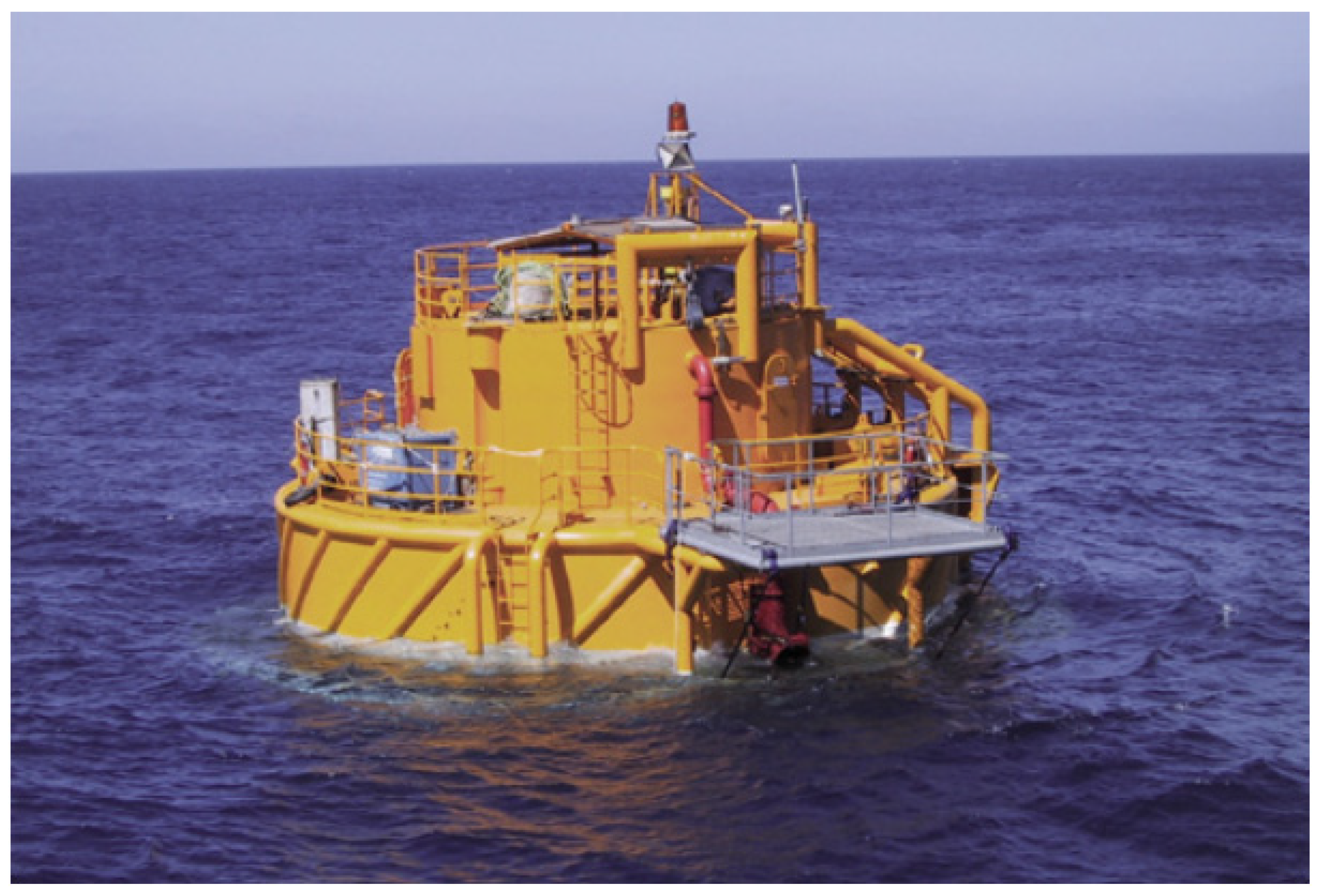
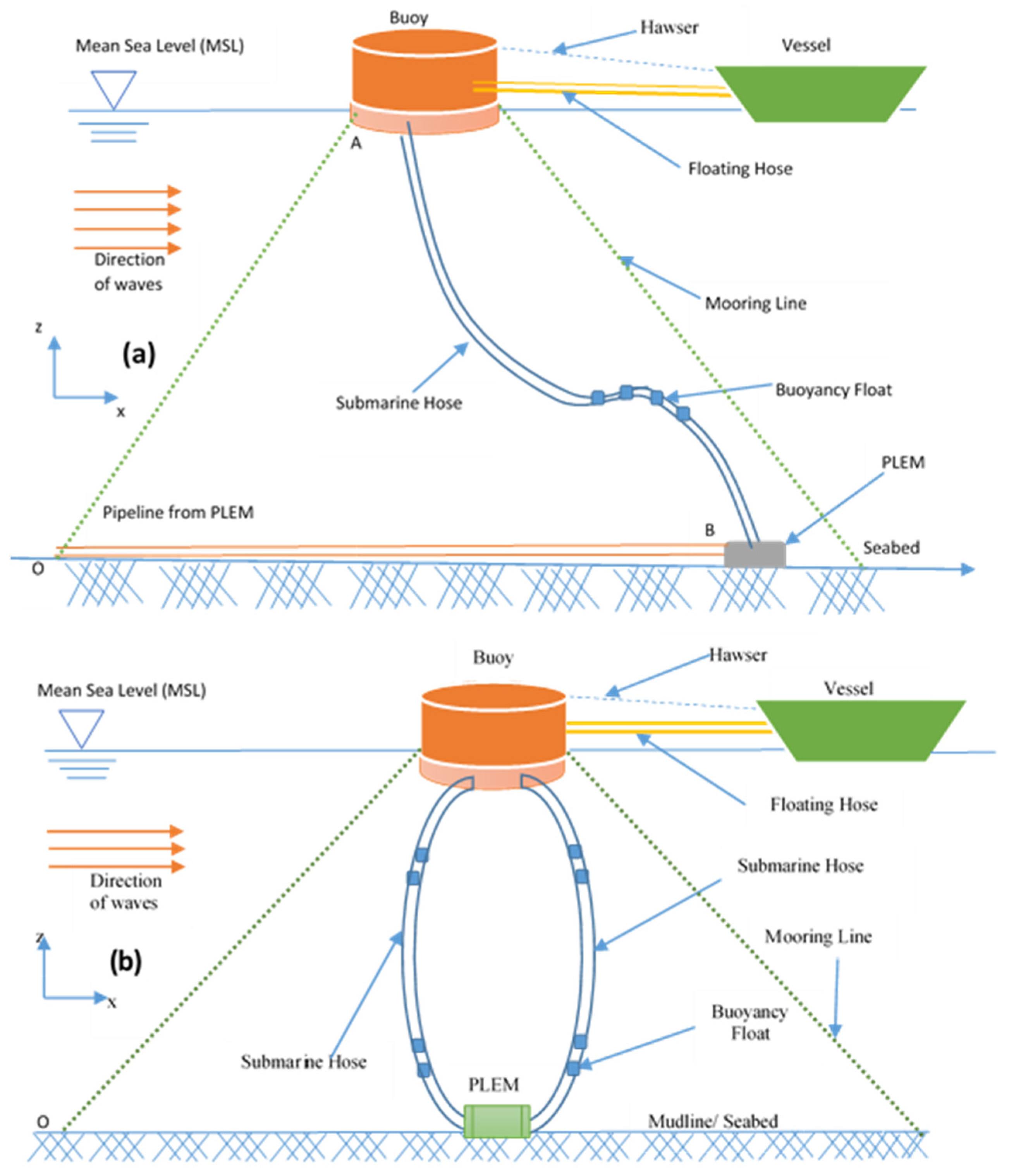
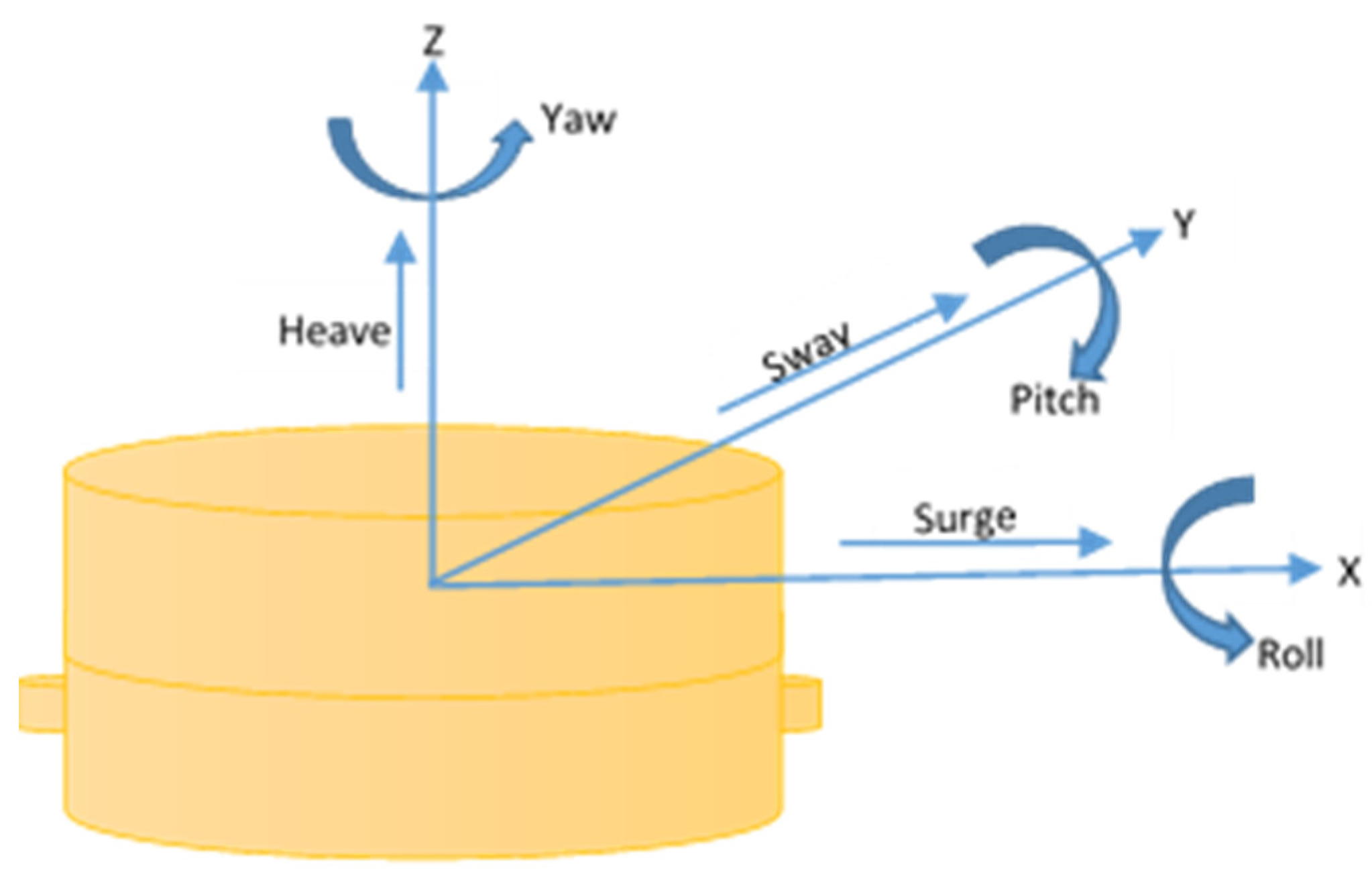

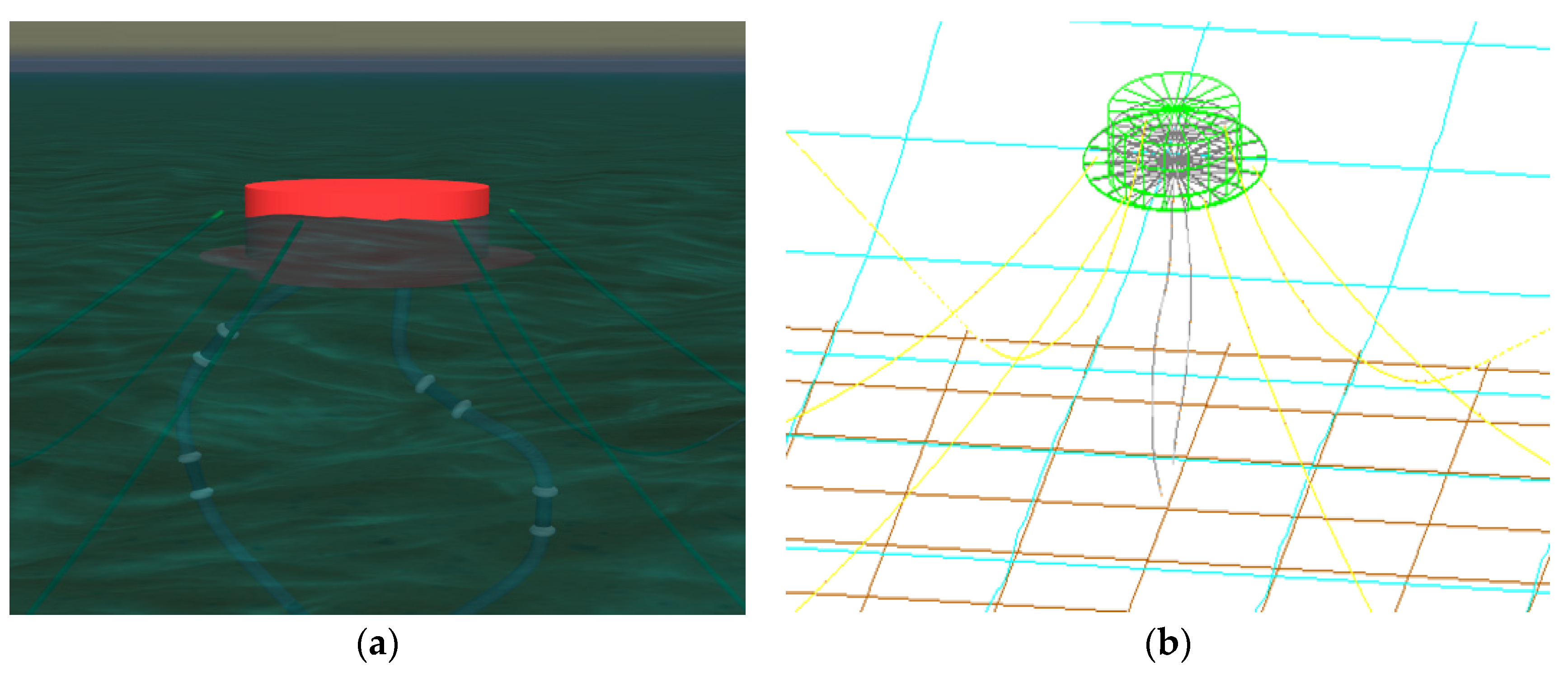
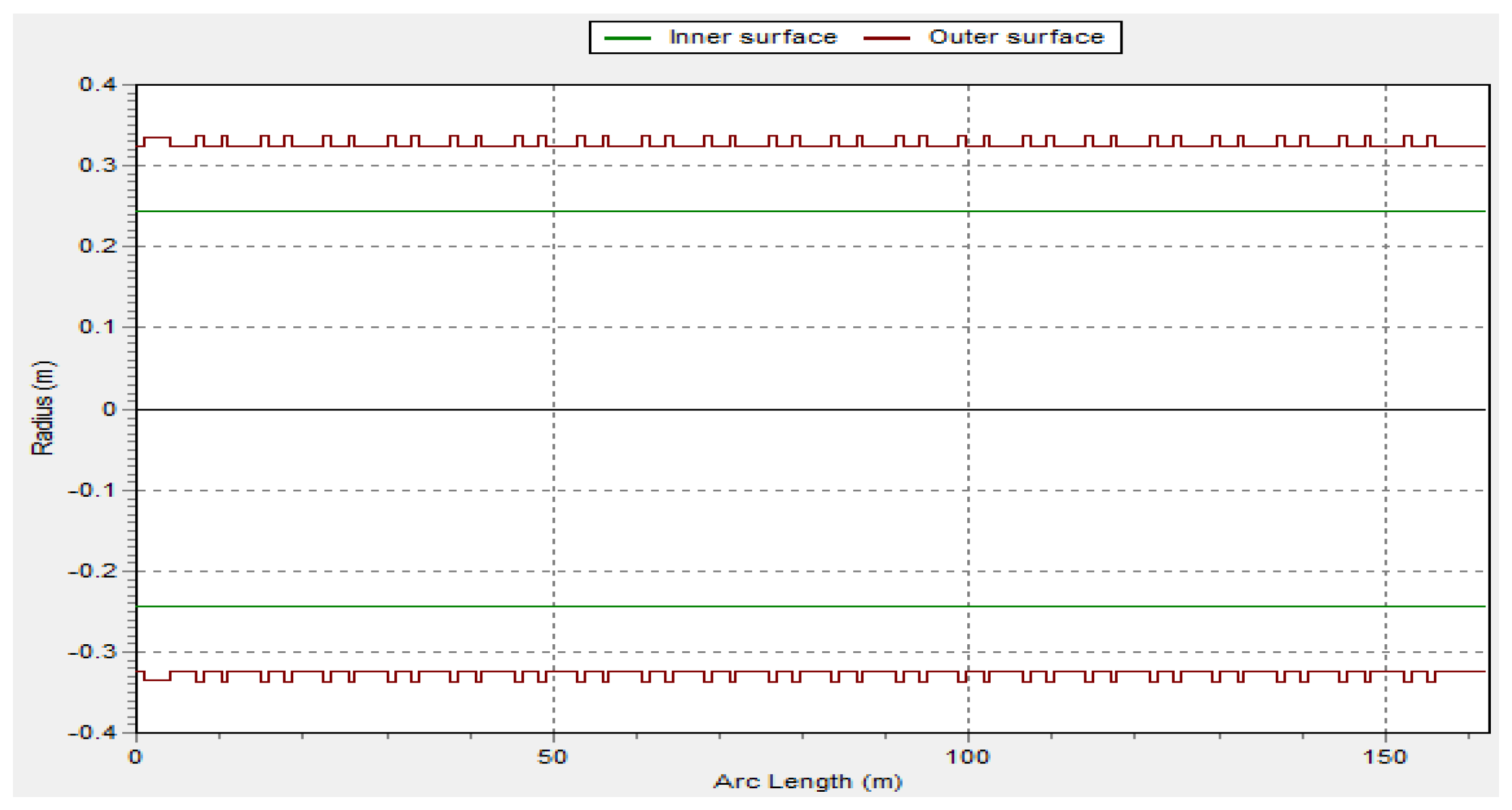
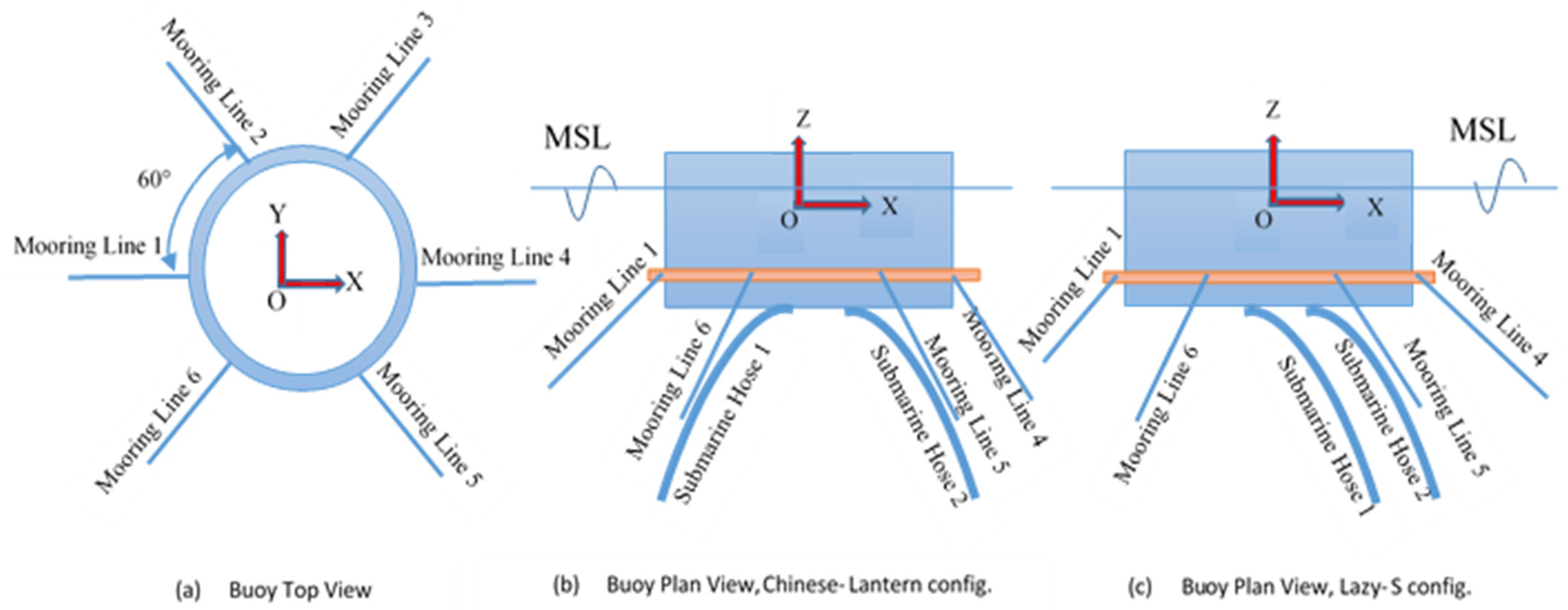

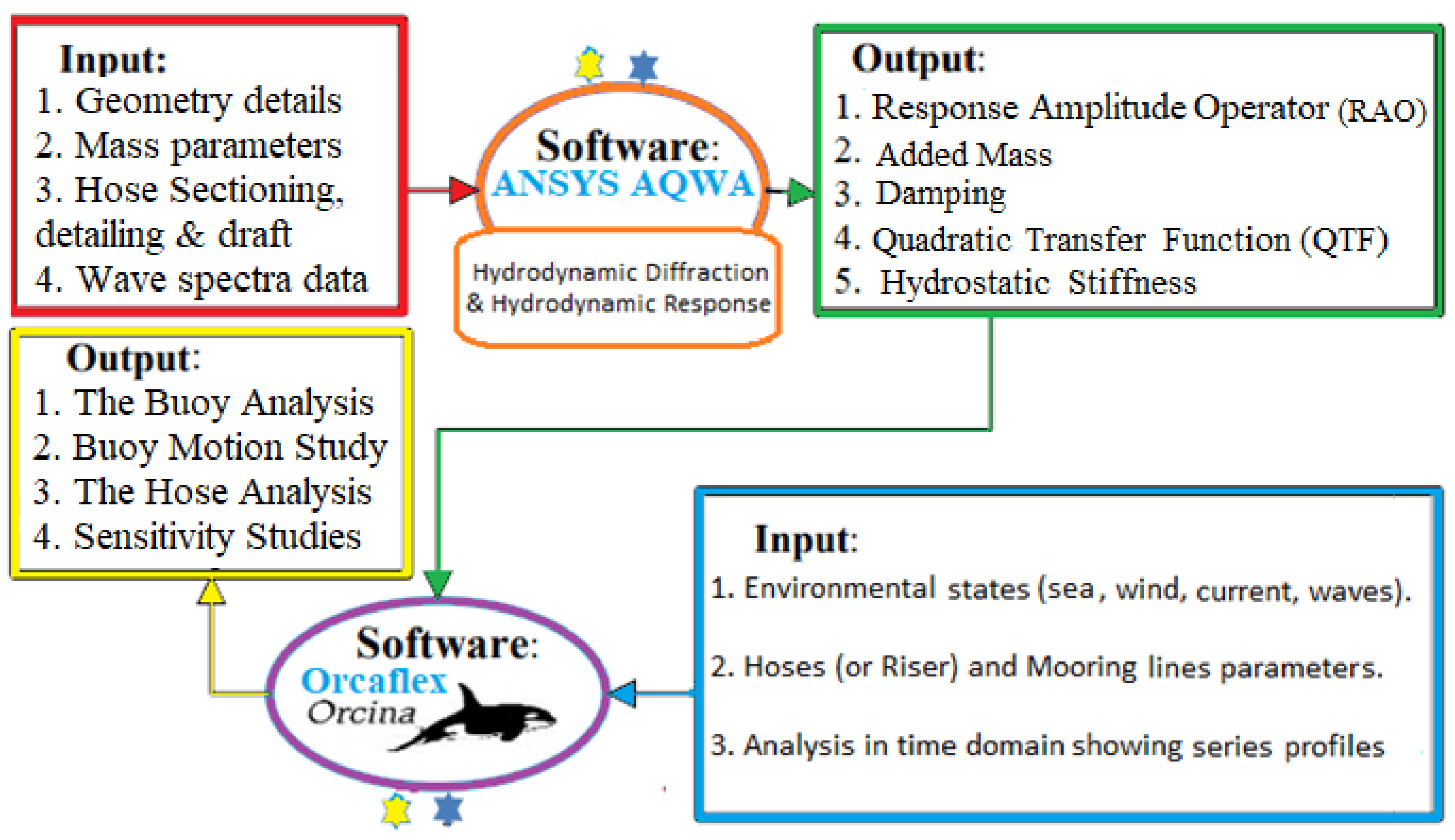
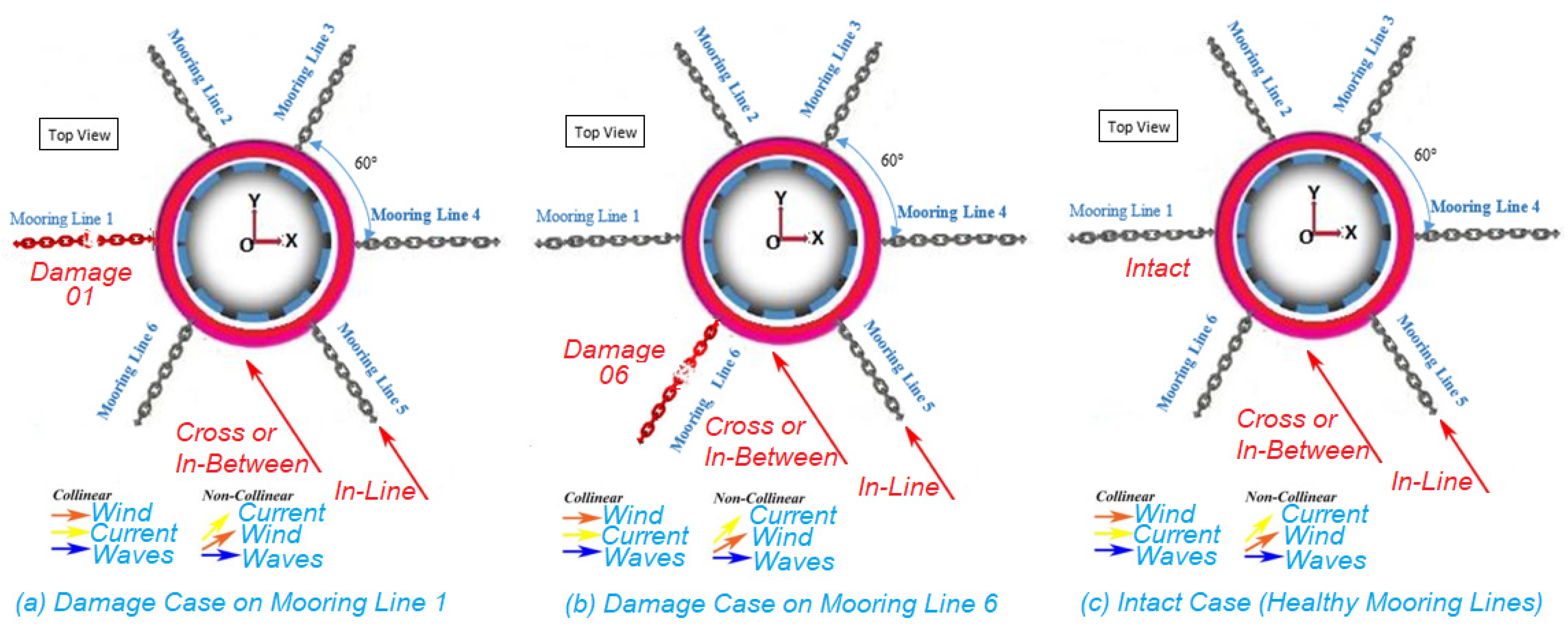
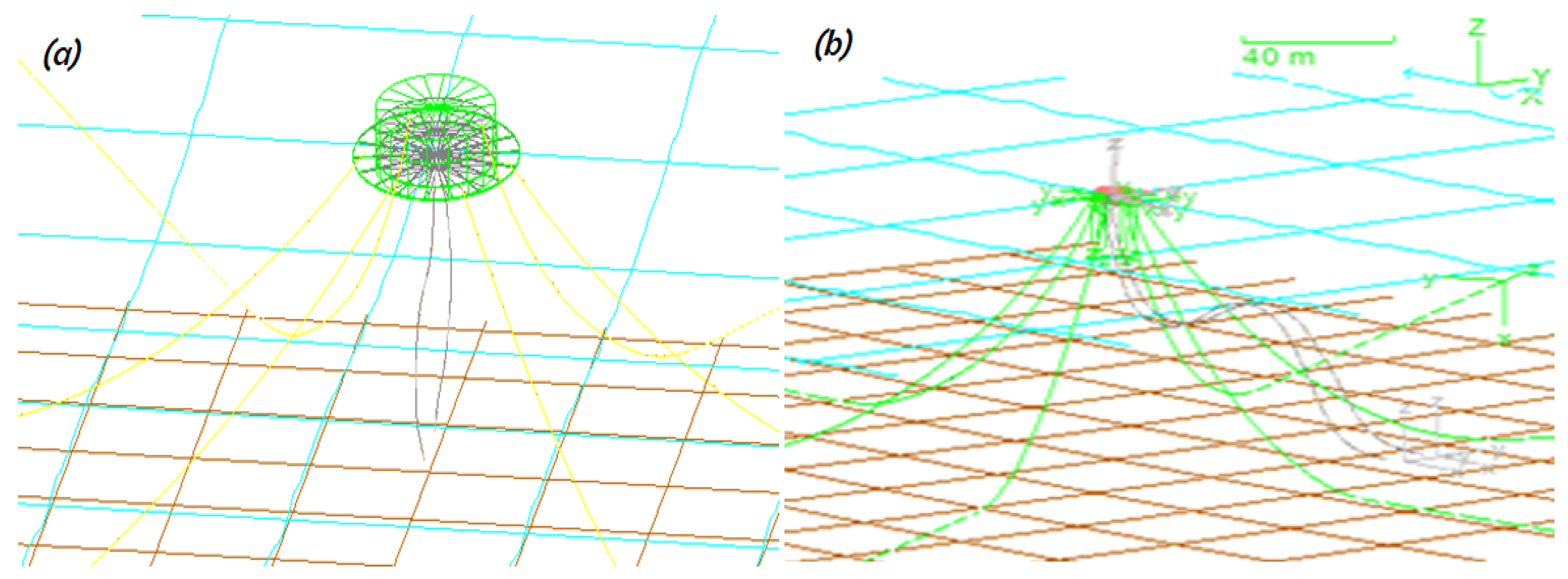
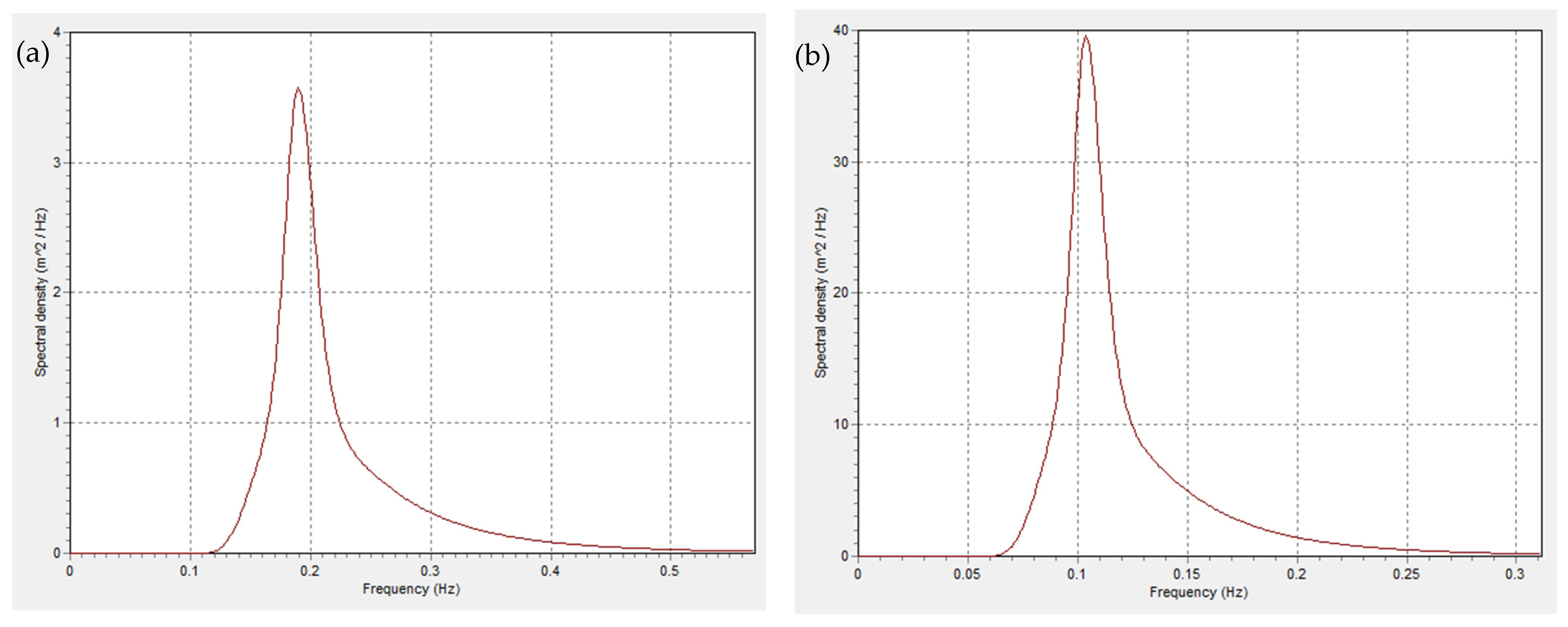
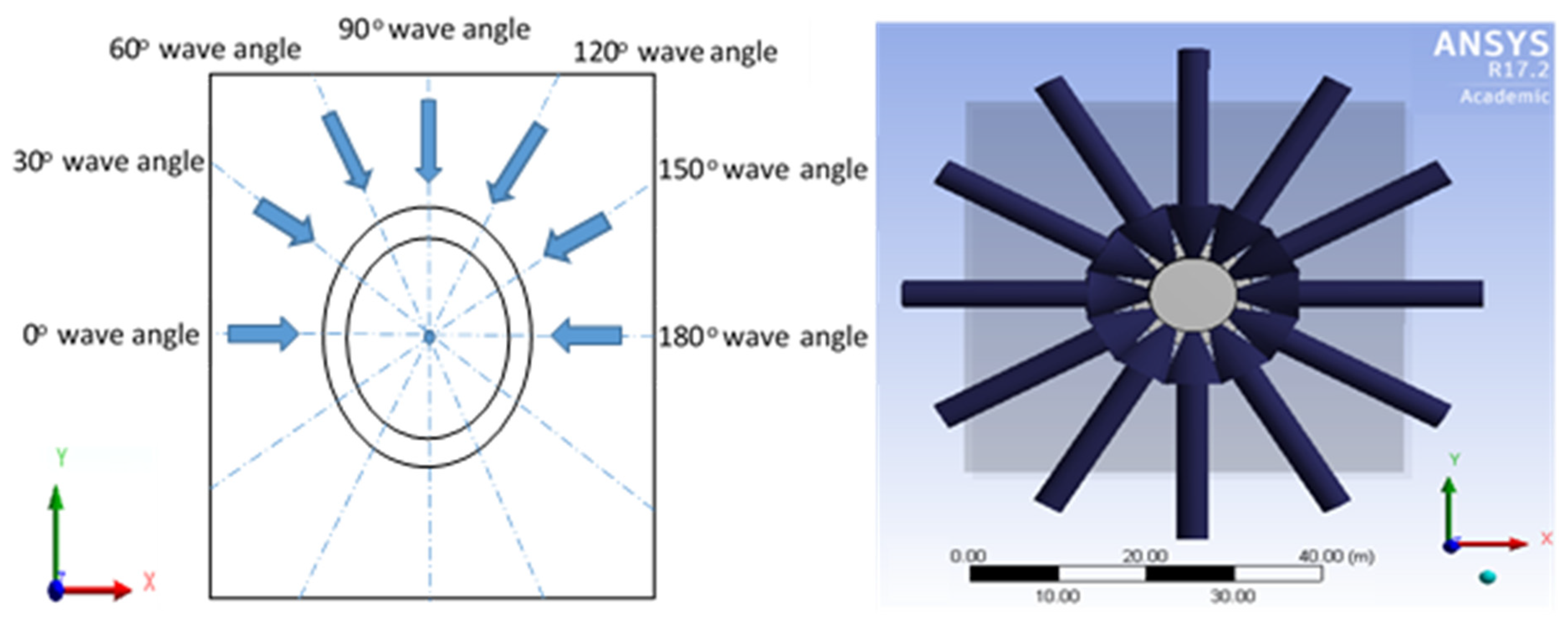
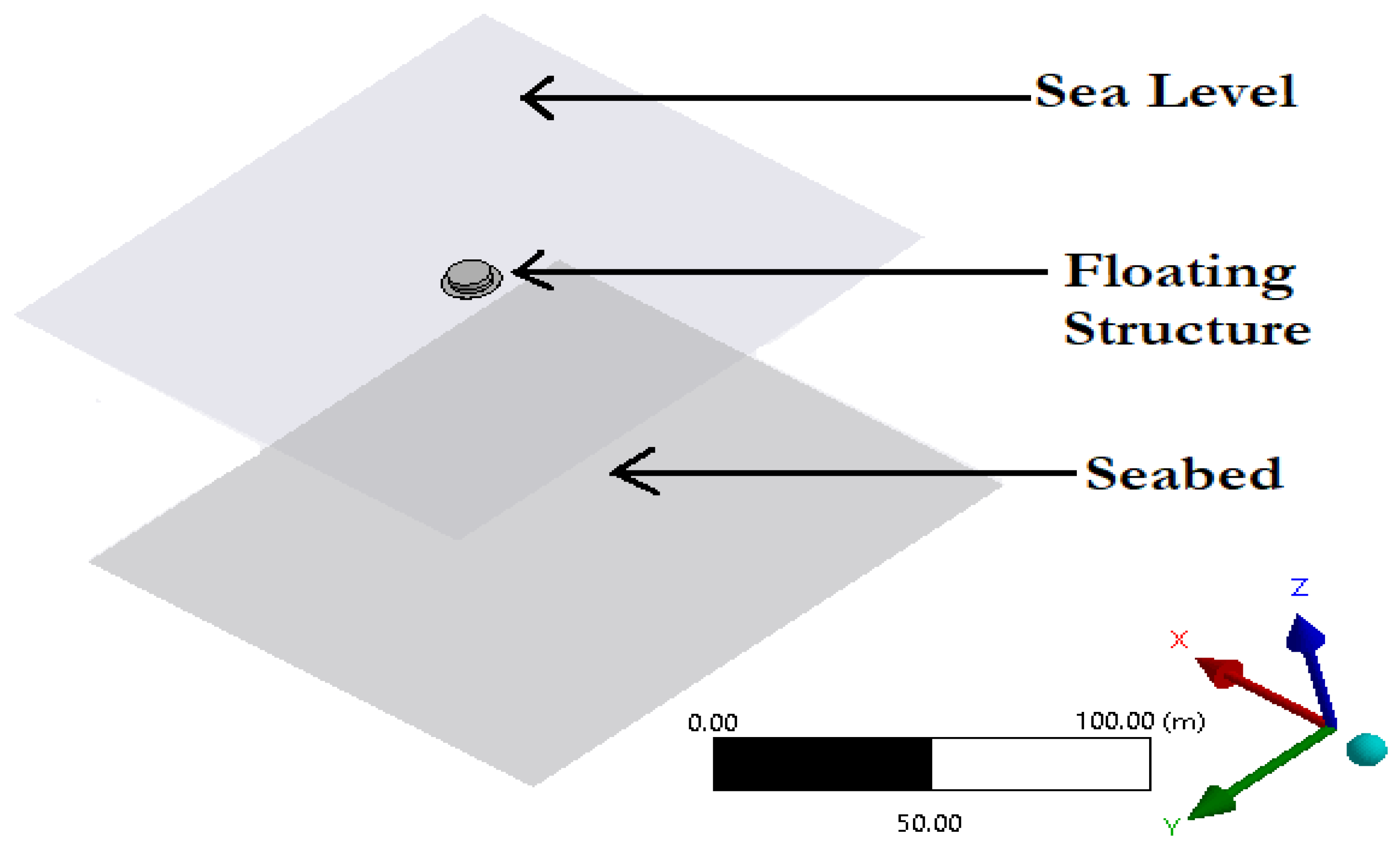
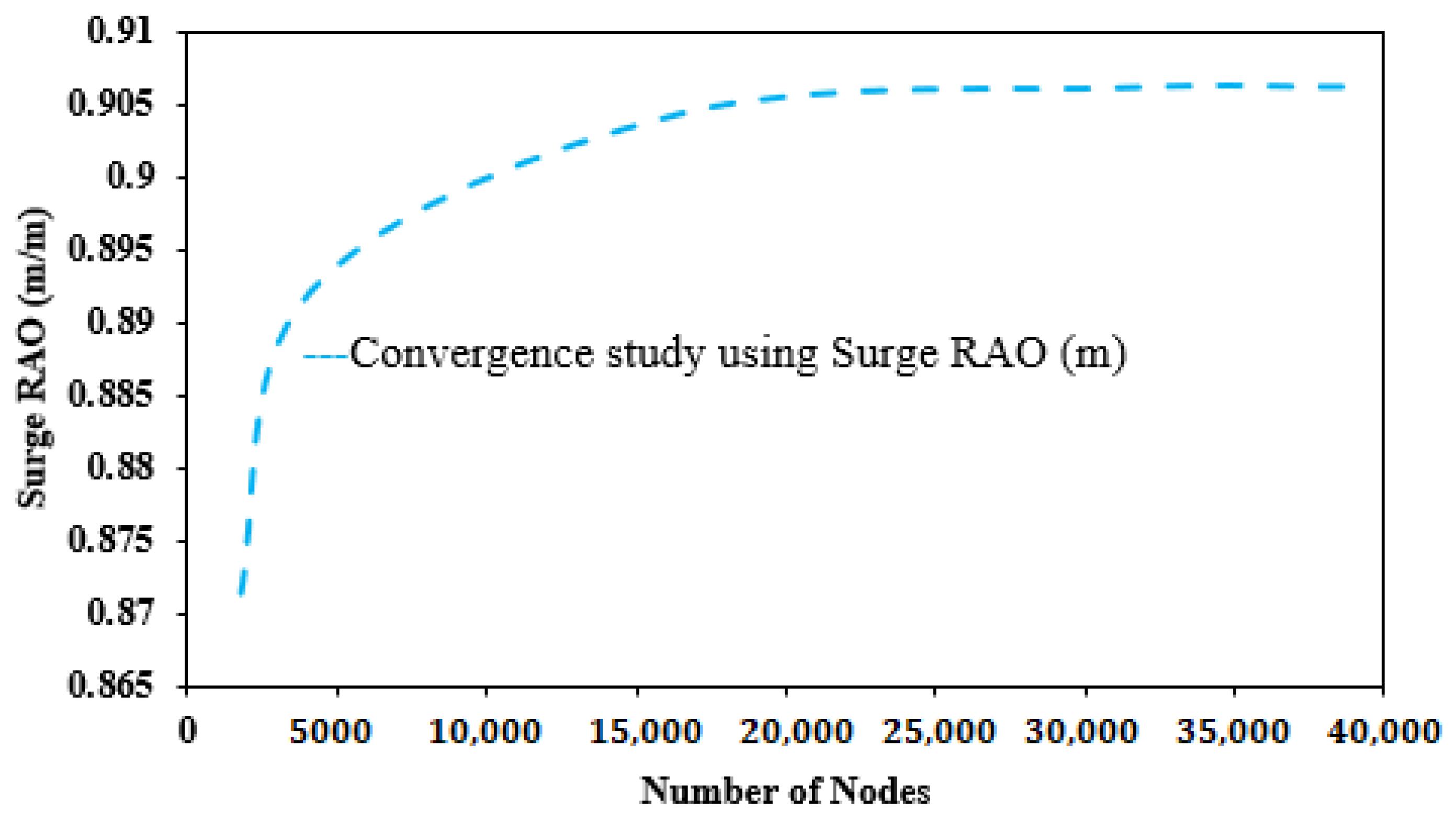


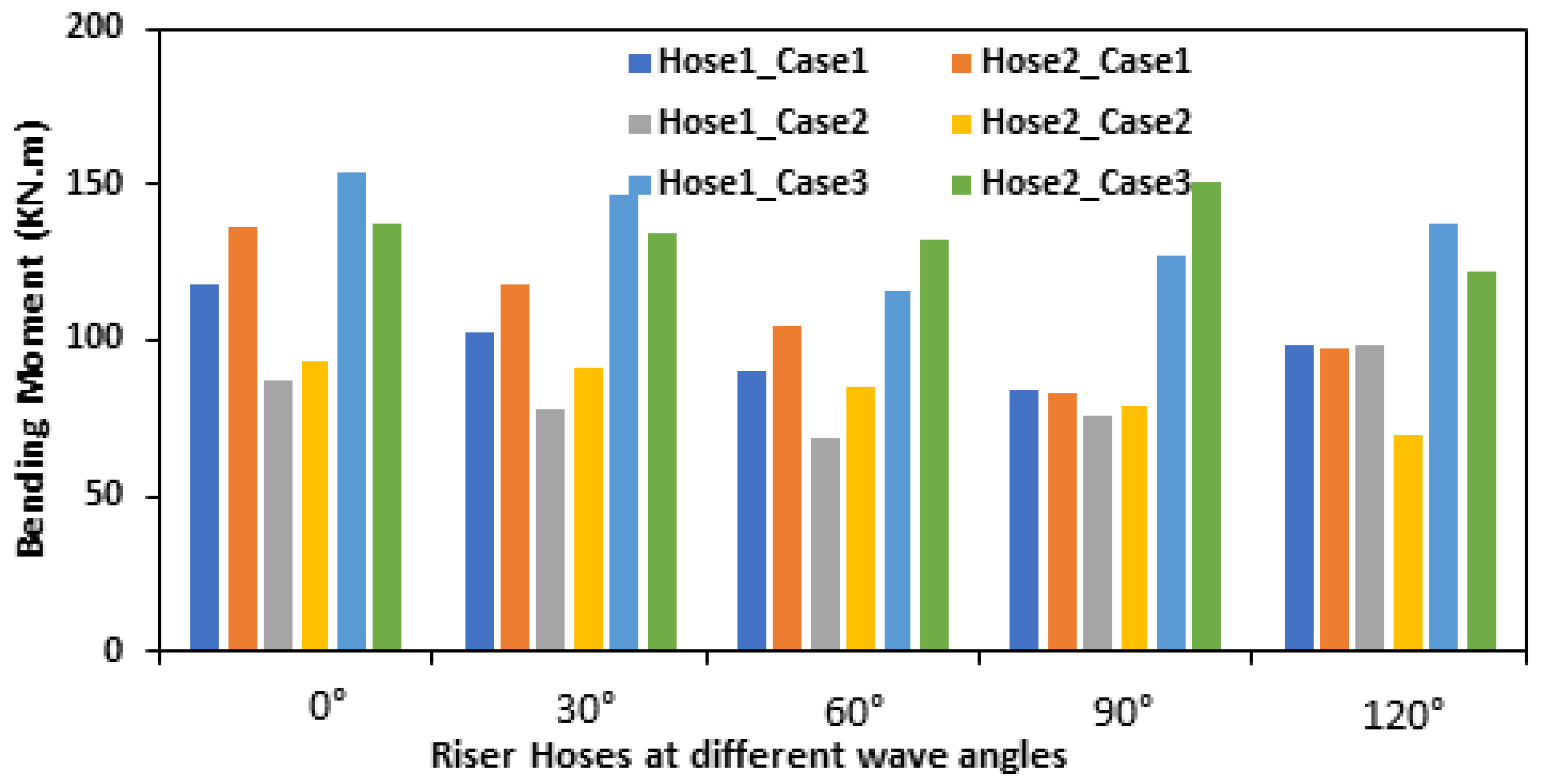
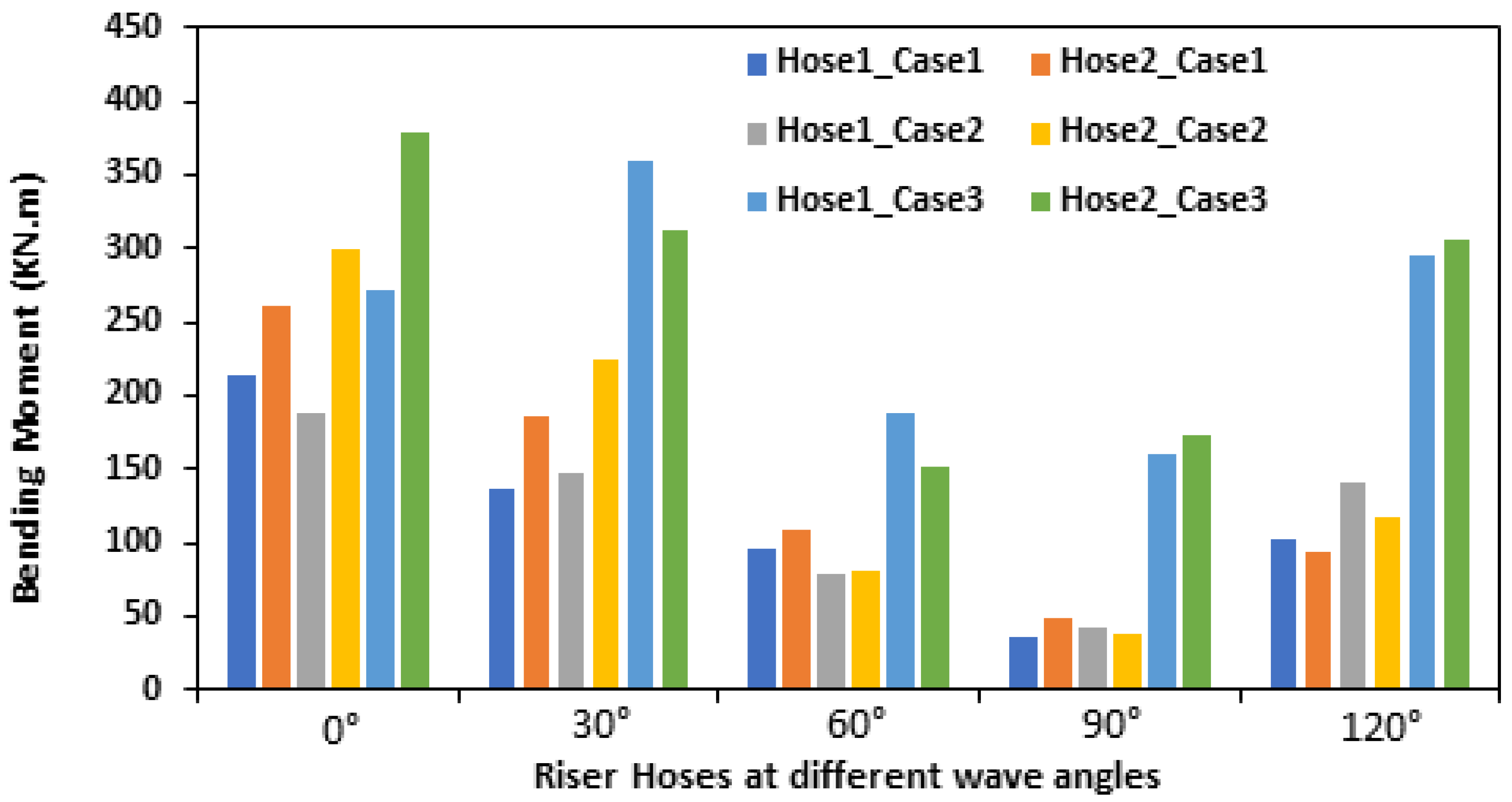
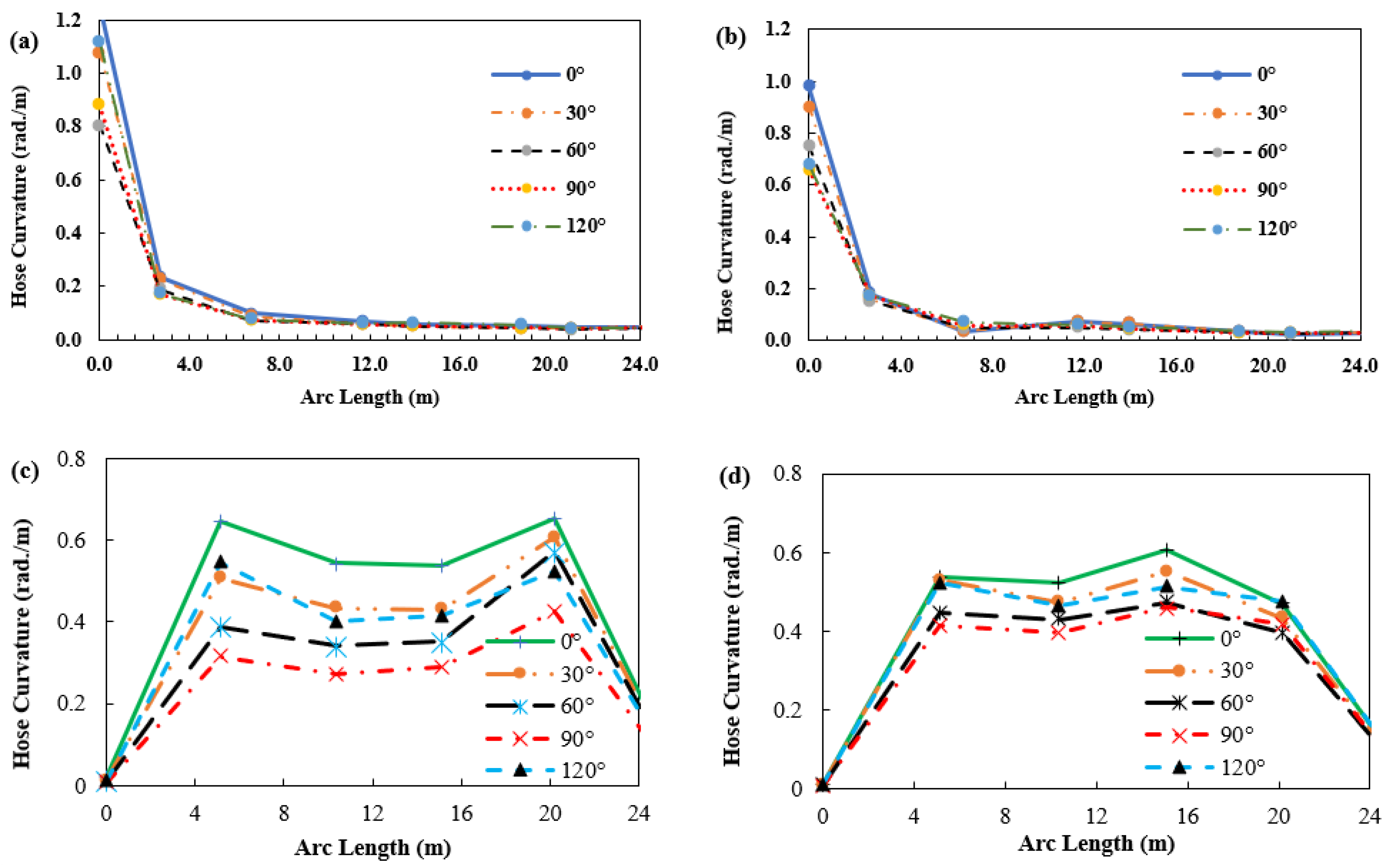
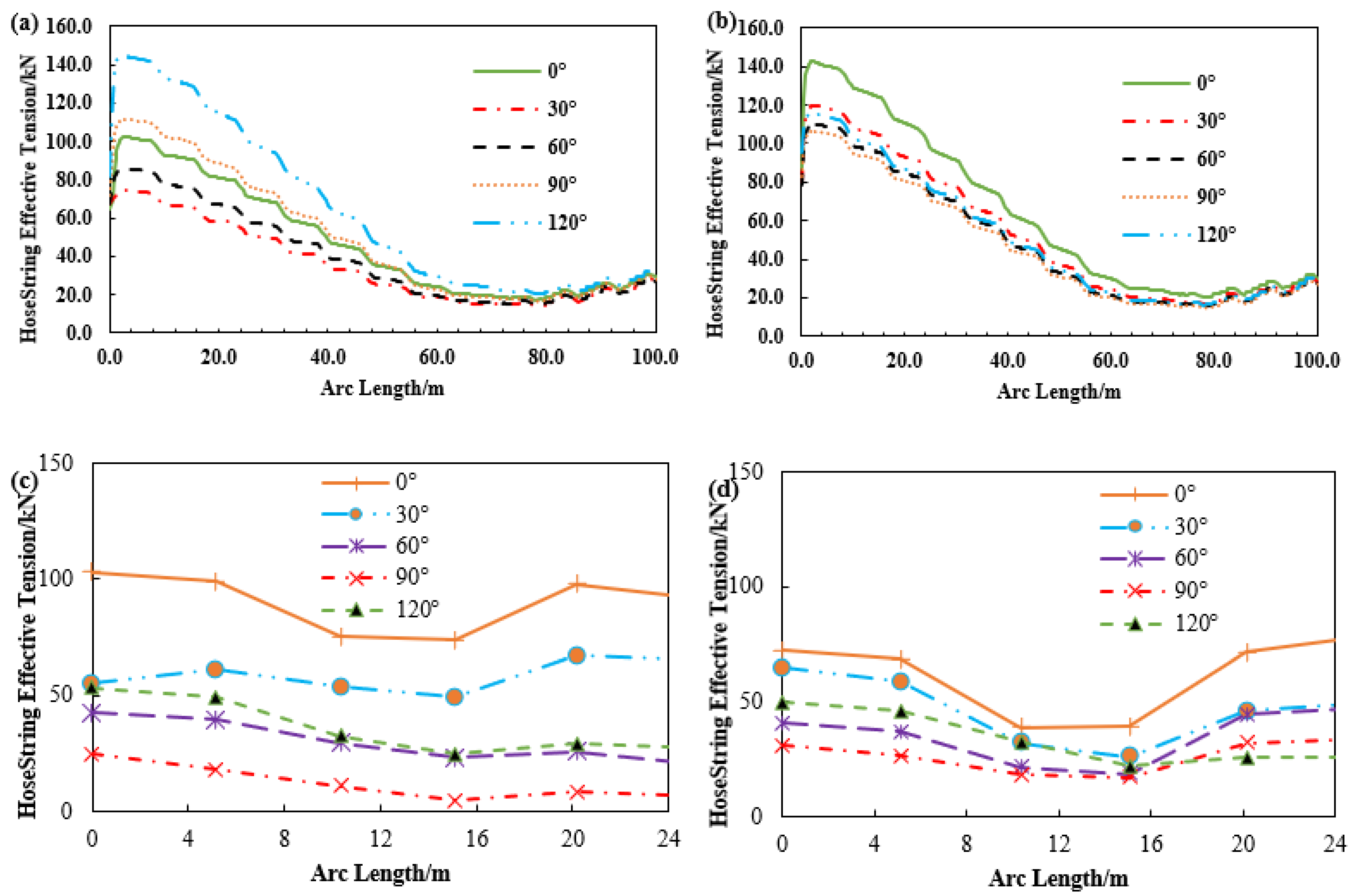
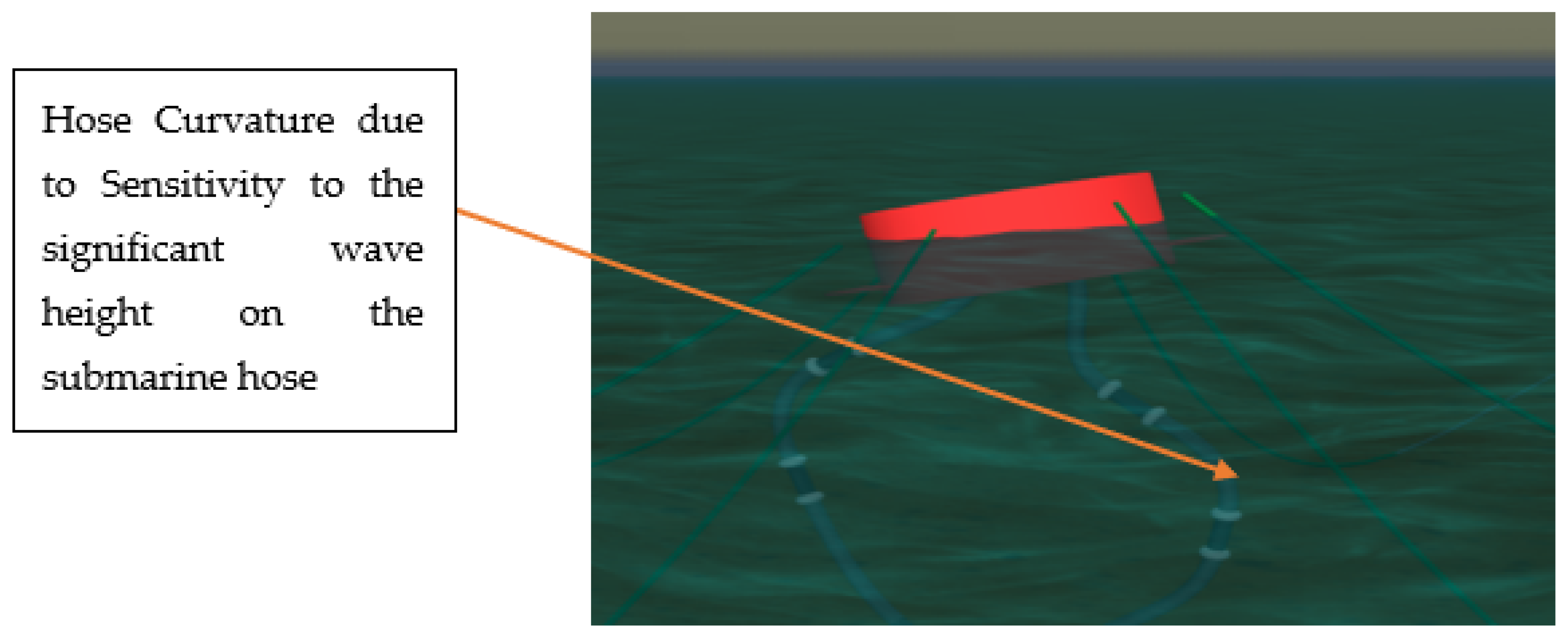
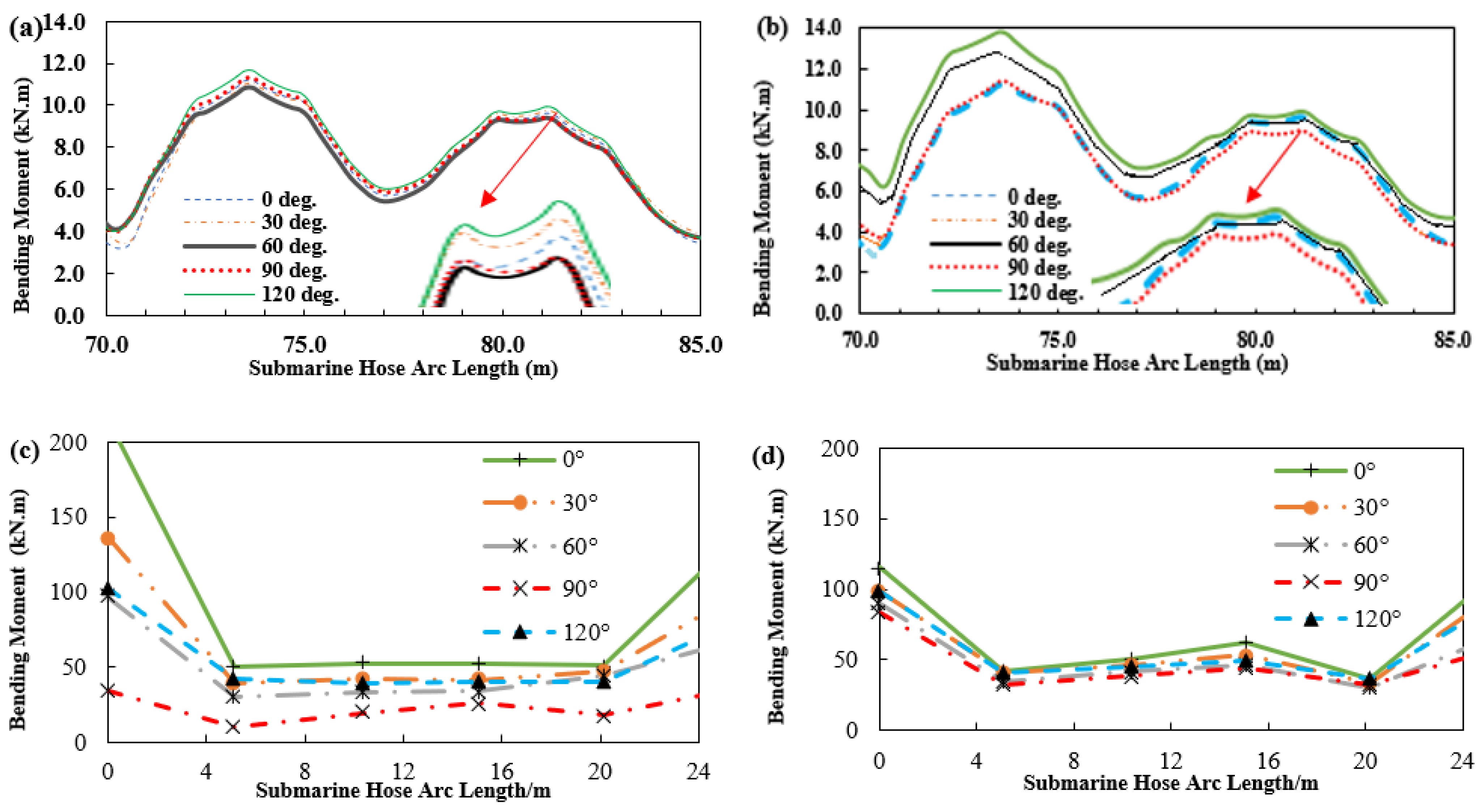
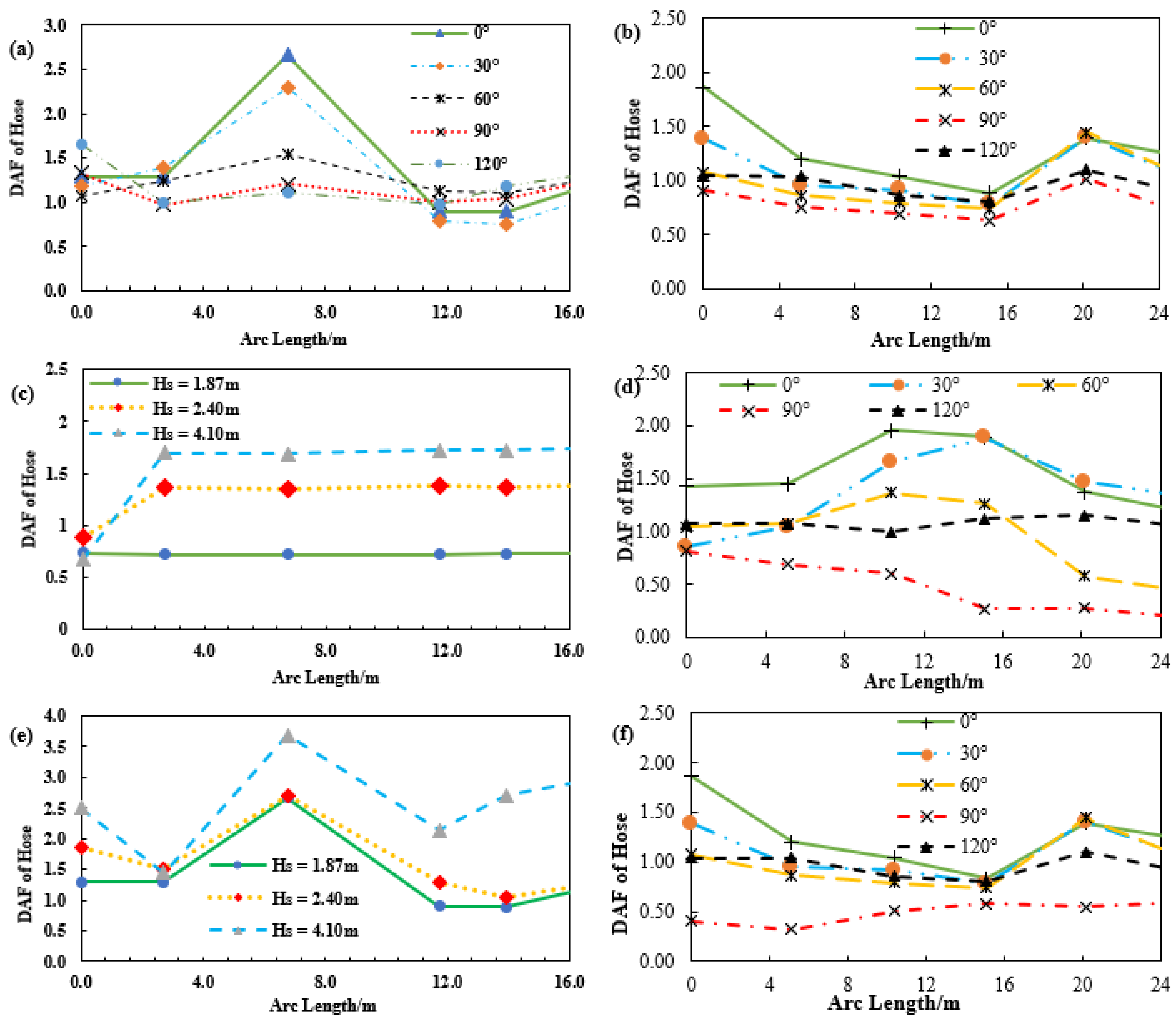
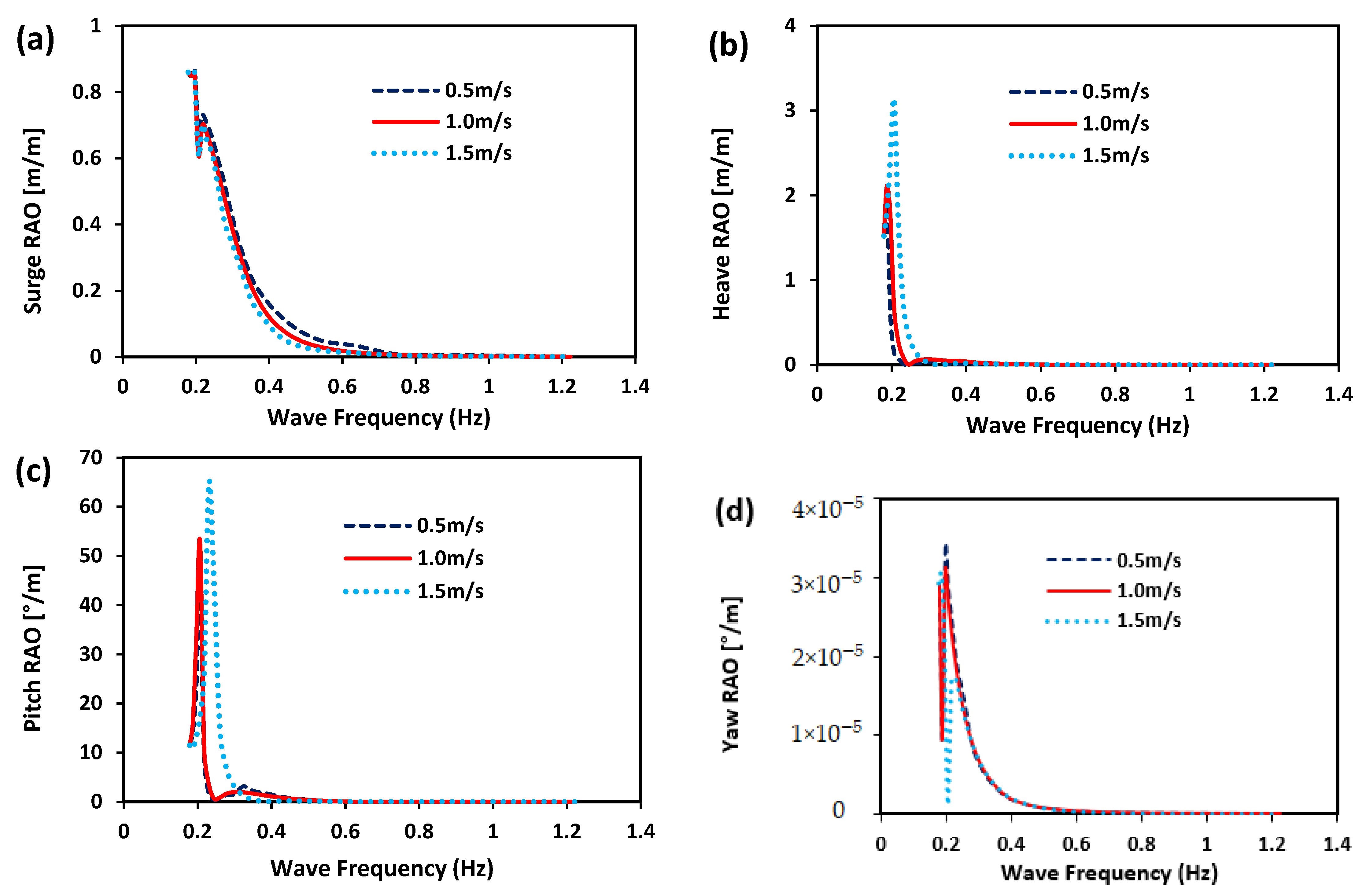
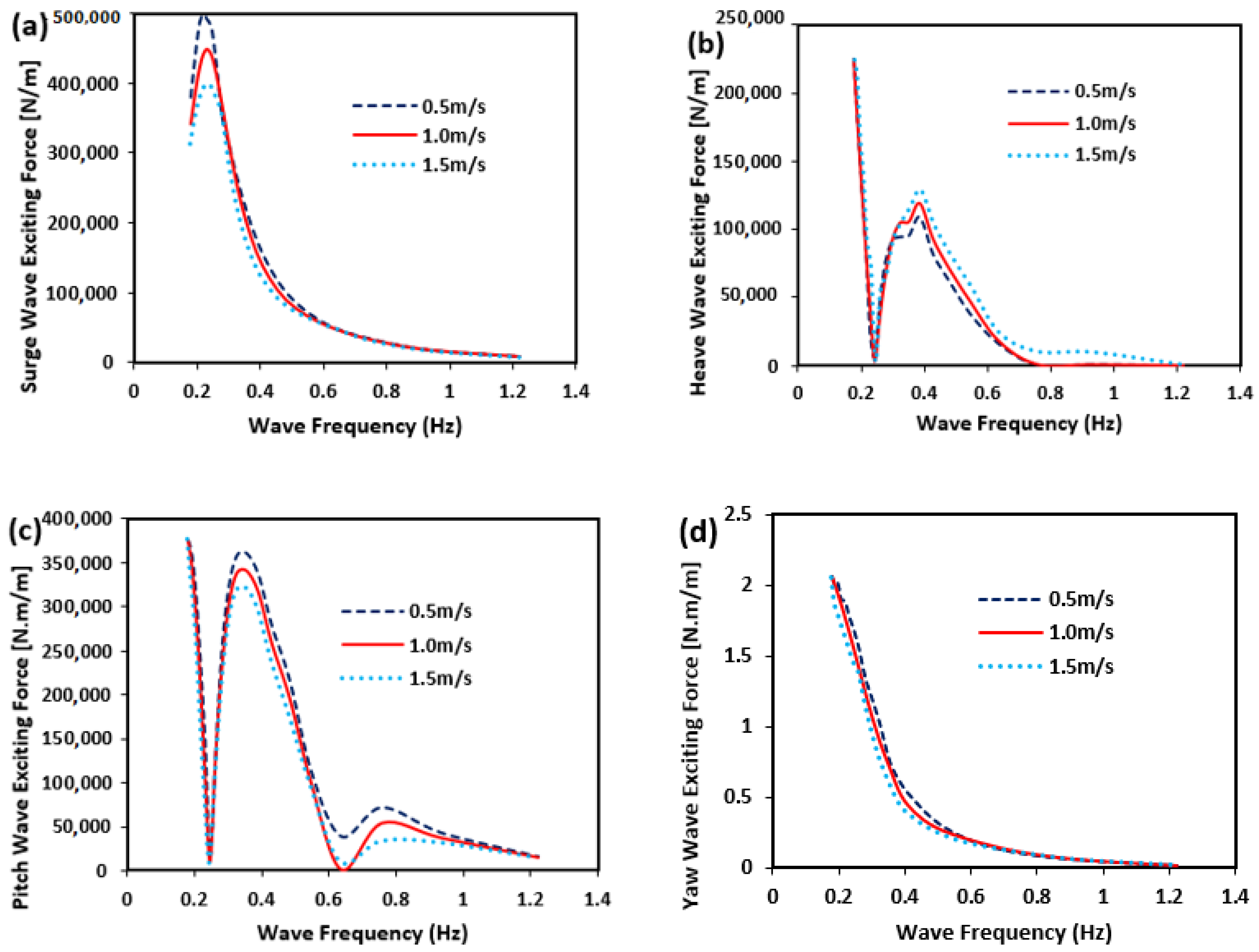
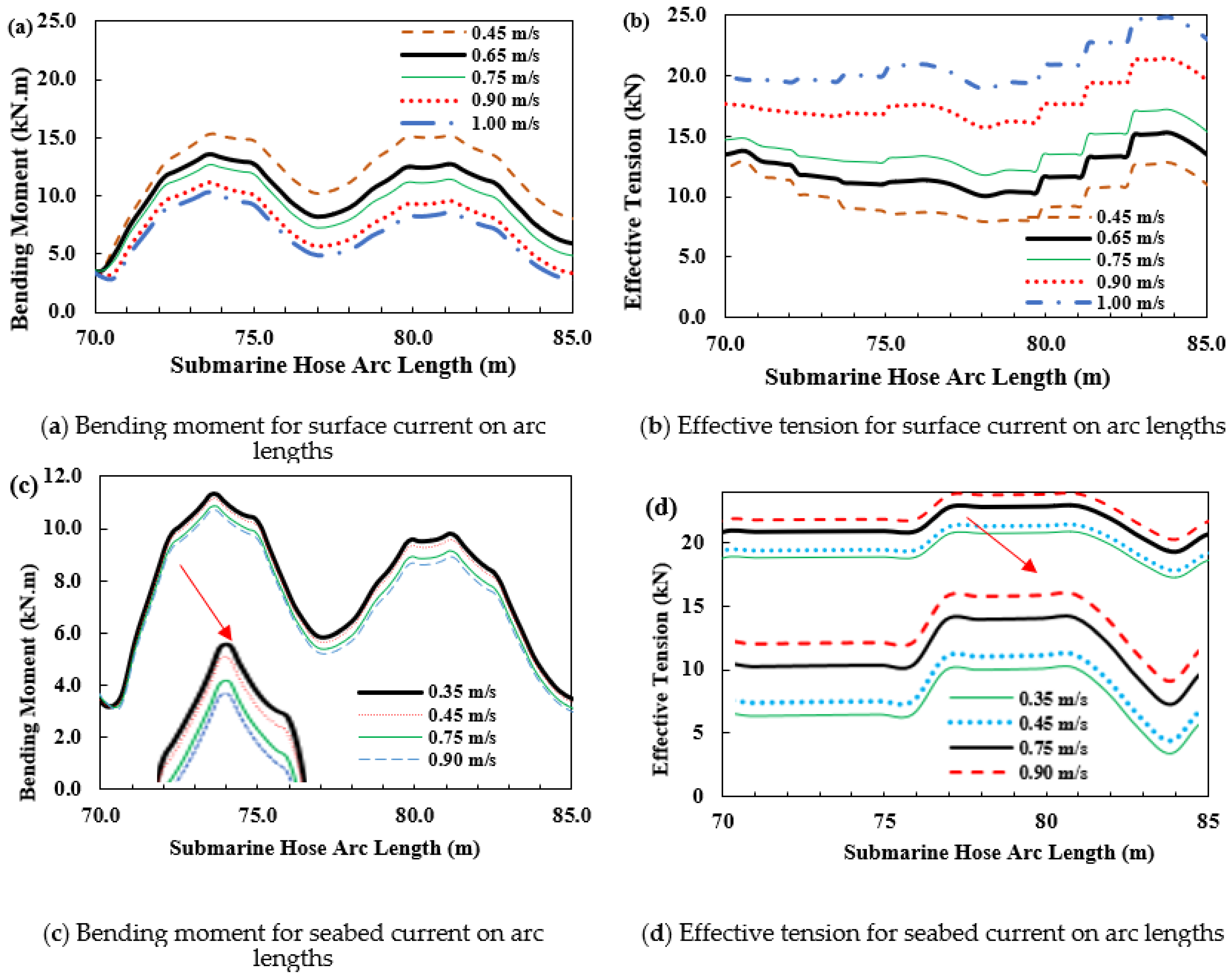

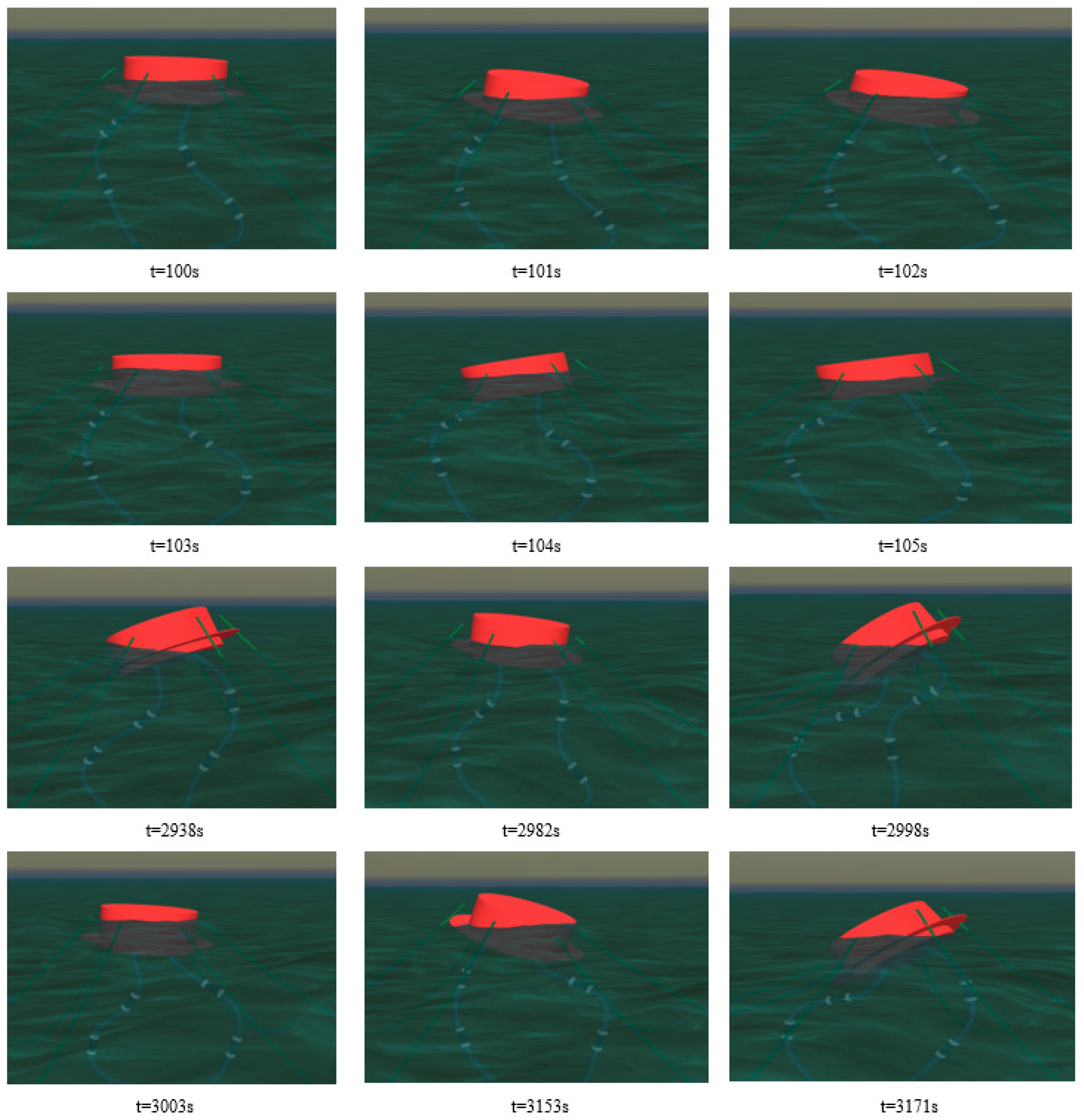
| Description | Value | Unit |
|---|---|---|
| Buoy Height | 4.50 | m |
| Draft | 2.40 | m |
| Water Depth | 100.00 | m |
| Buoy Mass | 19,883,400 | kg |
| Diameter of Buoy body | 10.00 | m |
| Diameter of Buoy Skirt | 13.90 | m |
| Particulars | Description and Value | Unit | ||
|---|---|---|---|---|
| Name | First-off Buoy hose | Mainline hose | First-off PLEM + floats | - |
| Position of Part | 1st Section | 2nd Section | 3rd Section | - |
| Hose Type Illustration |  |  |  | - |
| Hose Body Array | V1 (Hose Fitting) | V2 (Hose Fitting) | V3 (Hose Fitting) | - |
| V1 (Reinforced end) | V2 (Hose End) | V3 (Hose End) | - | |
| V1 (Hose Body) | V2 (Hose Body) | V3 (Hose Body) | - | |
| V2 (Hose End) | V3 (Reinforced end) | - | ||
| V1 (Hose Fitting) | V2 (Hose Fitting) | V3 (Hose Fitting) | - | |
| Hose Section Mass | 239.00 | 495.00 | 239.00 | kg/m |
| Hose Outer Diameter, OD | 0.67 | 0.65 | 0.67 | m |
| Hose Inner Diameter, ID | 0.49 | 0.49 | 0.49 | m |
| Hose Length, L | 8.40 | 9.00 | 8.50 | m |
| Section Number | Sub- Sections | Particulars | Inner Diameter (m) | Outer Diameter (m) | Section Length (m) | Segment Length (m) | Number of Segments | Unit Mass (kg/m) | Volume (m3) | Segment Weight (N) |
|---|---|---|---|---|---|---|---|---|---|---|
| Hose Group 1: Section 1 | 1 | Fitting | 0.489 | 0.650 | 1.0 | 0.800 | 1 | 495 | 0.330 | 492.5 |
| 2 | Reinforced Hose End | 0.489 | 0.650 | 0.2 | 3.000 | 15 | 239 | 1.002 | 721.5 | |
| 3 | Hose Body | 0.489 | 0.650 | 0.5 | 3.236 | 6 | 180 | 1.074 | 582.5 | |
| 4 | Hose End | 0.489 | 0.675 | 0.5 | 0.895 | 2 | 200 | 0.320 | 179.0 | |
| 5 | Fitting | 0.489 | 0.650 | 1.0 | 0.800 | 1 | 495 | 0.330 | 492.5 | |
| Hose Group 2: Section 2–Section 20 (same) | 6 | Fitting | 0.489 | 0.650 | 1.0 | 0.800 | 1 | 495 | 0.330 | 492.5 |
| 7 | Hose End | 0.489 | 0.675 | 0.5 | 0.895 | 2 | 200 | 0.320 | 179.0 | |
| 8 | Hose Body | 0.489 | 0.650 | 0.2 | 3.840 | 19 | 180 | 1.274 | 691.2 | |
| 9 | Hose End | 0.489 | 0.675 | 0.5 | 0.895 | 2 | 200 | 0.320 | 179.0 | |
| 10 | Fitting | 0.489 | 0.650 | 1.0 | 0.800 | 1 | 495 | 0.330 | 492.5 | |
| Hose Group 3: Section 21 | 11 | Fitting | 0.489 | 0.650 | 1.0 | 0.800 | 1 | 495 | 0.330 | 492.5 |
| 12 | Hose End | 0.489 | 0.675 | 0.5 | 0.895 | 2 | 200 | 0.320 | 179.0 | |
| 13 | Hose Body | 0.489 | 0.650 | 0.5 | 3.236 | 6 | 180 | 1.074 | 582.5 | |
| 14 | Reinforced Hose End | 0.489 | 0.670 | 0.2 | 3.000 | 15 | 240 | 1.064 | 724.6 | |
| 15 | Fitting | 0.489 | 0.650 | 1.0 | 0.800 | 1 | 495 | 0.330 | 492.5 |
| Description | Value | Unit |
|---|---|---|
| Coefficient of Drag, Cd | 1.00 | - |
| Coefficient of Inertia, Cm | 1.00 | - |
| Section Lengths Ratio for the first config. | 150:195 | - |
| Section Lengths Ratio for the second config. | 50:175 | - |
| Poisson Ratio | 0.50 | - |
| Mass Per Unit Length | 0.088 | te/m |
| Contact Diameter | 0.229 | m |
| Nominal Diameter | 0.120 | m |
| Bending Stiffness | 0.00 | N·m2 |
| Axial Stiffness, EA | 407,257.00 | kN |
| Separation Angle between lines | 60 | Degrees (°) |
| Item | Value | Item | Value |
|---|---|---|---|
| Classification of Float | Standard float | Unit Mass, w (kg) | 102.00 |
| Float Type | Bolted type | Net Buoyancy, bf (kg) | 280.00 |
| Filling Material | Polyurethane foam | Outer Diameter, Do (m) | 1.23 |
| Metal Part Material | Stainless Steel | Inner Diameter, Df (m) | 0.799 |
| Shell Material | Polyethylene | Length of Float, Lf (m) | 0.60 |
| Number of floats | Depends on config. | Pitch of Floats, Sf (m) | 2.00 |
| Condition | Mooring | Tanker | Heading | Configuration |
|---|---|---|---|---|
| Operation | Damage | Yes | In-line | Lazy-S Chinese-lantern |
| Yes | In between or Cross | |||
| Intact | Yes | In-line | ||
| Yes | In between or Cross | |||
| Survival | Damage | Yes | In-line | Lazy-S Chinese-lantern |
| Yes | In between or Cross | |||
| Intact | Yes | In-line | ||
| Yes | In between or Cross | |||
| Extreme | Damage | No | In-line | Lazy-S Chinese-lantern |
| No | In between or Cross | |||
| Intact | No | In-line | ||
| No | In between or Cross |
| Item | Value | Unit |
|---|---|---|
| Ocean Temperature | 10 | °C |
| Ocean Kinematic Viscosity of Ocean | 1.35 × 10−6 | m2 s−1 |
| Density of Water | 1025 | Kg m−3 |
| Wave Amplitude | 0.145 | m |
| Seabed Stiffness | 7.5 | kN m−1 m2 |
| Seabed Shape Direction | 0 | ° |
| Water Depth | 26.0 m (Chinese-lantern) and 100.0 m (Lazy-S) | m |
| Seabed Friction Coefficient | 0.5 | - |
| Seabed Model Type | Elastic Linear and Rigid Nonlinear Soil Models | - |
| Case No. | HS (m) | TZ (s) | TP (s) | Conditions | Wave Angles (°) | Hydrodynamic Loads (HL) |
|---|---|---|---|---|---|---|
| 01 | 1.87 | 4.40 | 5.50 | Operation | 0, 30, 60, 90, 120 | Coupled (has HL), Uncoupled (no HL) |
| 02 | 2.40 | 6.10 | 7.85 | Extreme | 0, 30, 60, 90, 120 | Coupled (has HL), Uncoupled (no HL) |
| 03 | 4.10 | 5.50 | 9.65 | Survival | 0, 30, 60, 90, 120 | Coupled (has HL), Uncoupled (no HL) |
| Item | Value | Unit |
|---|---|---|
| Current Direction | 180.00 | ° |
| Surface Current | 0.50 | ms−1 |
| Seabed Current | 0.45 | ms−1 |
| Wind Speed | 22.00 | ms−1 |
| Wind Type | Constant | - |
| Density of Air | 1.225 | Kg m−3 |
| Kinematic Viscosity of Air | 0.000015 | m2 s−1 |
| Item | Value | Unit |
|---|---|---|
| Buoy Area | 438.49 | m2 |
| Buoy Volume | 344.98 | m3 |
| Ixx (Moment of Inertia) | 433,137,937 | kg m2 |
| Iyy (Moment of Inertia) | 448,667,411 | kg m2 |
| Izz (Moment of Inertia) | 433,137,937 | kg m2 |
| CoG (Centre of Gravity) | −2.20 | m |
| Bf (Buoyancy Force) | 196,750,000 | N |
| Mesh Size | Nodes | Elements | Surge RAO (m/m) | Max. RAO Variance from 0.225 m | Max. RAO Deviation from 0.225 m |
|---|---|---|---|---|---|
| 0.225 | 38,572 | 38,570 | 0.90610 | 0.000000 | 0.00000% |
| 0.25 | 31,554 | 31,552 | 0.90605 | 0.000000 | 0.00004% |
| 0.35 | 16,464 | 16,462 | 0.90427 | 0.000016 | 0.00126% |
| 0.75 | 4070 | 4068 | 0.89206 | 0.000075 | 0.00863% |
| 1.25 | 1628 | 1626 | 0.87012 | 0.000241 | 0.01551% |
| Parameters | Bending Moment (KN.m) | Average Ratio (Uncoupled/Coupled) | |
|---|---|---|---|
| Uncoupled Model | Coupled Model | ||
| Hose1_Case1 | 117.6735 | 214.4112 | 0.54882161 |
| Hose2_Case1 | 136.5212 | 261.0225 | 0.523024643 |
| Hose1_Case2 | 87.54206 | 188.5113 | 0.464386273 |
| Hose2_Case2 | 93.11749 | 298.8106 | 0.311627131 |
| Hose1_Case3 | 153.9478 | 270.7054 | 0.568691278 |
| Hose2_Case3 | 137.3706 | 379.3597 | 0.362111737 |
| Total | 726.17265 | 1612.8207 | 2.778662673 |
Publisher’s Note: MDPI stays neutral with regard to jurisdictional claims in published maps and institutional affiliations. |
© 2022 by the authors. Licensee MDPI, Basel, Switzerland. This article is an open access article distributed under the terms and conditions of the Creative Commons Attribution (CC BY) license (https://creativecommons.org/licenses/by/4.0/).
Share and Cite
Amaechi, C.V.; Wang, F.; Ye, J. Investigation on Hydrodynamic Characteristics, Wave–Current Interaction and Sensitivity Analysis of Submarine Hoses Attached to a CALM Buoy. J. Mar. Sci. Eng. 2022, 10, 120. https://doi.org/10.3390/jmse10010120
Amaechi CV, Wang F, Ye J. Investigation on Hydrodynamic Characteristics, Wave–Current Interaction and Sensitivity Analysis of Submarine Hoses Attached to a CALM Buoy. Journal of Marine Science and Engineering. 2022; 10(1):120. https://doi.org/10.3390/jmse10010120
Chicago/Turabian StyleAmaechi, Chiemela Victor, Facheng Wang, and Jianqiao Ye. 2022. "Investigation on Hydrodynamic Characteristics, Wave–Current Interaction and Sensitivity Analysis of Submarine Hoses Attached to a CALM Buoy" Journal of Marine Science and Engineering 10, no. 1: 120. https://doi.org/10.3390/jmse10010120
APA StyleAmaechi, C. V., Wang, F., & Ye, J. (2022). Investigation on Hydrodynamic Characteristics, Wave–Current Interaction and Sensitivity Analysis of Submarine Hoses Attached to a CALM Buoy. Journal of Marine Science and Engineering, 10(1), 120. https://doi.org/10.3390/jmse10010120







